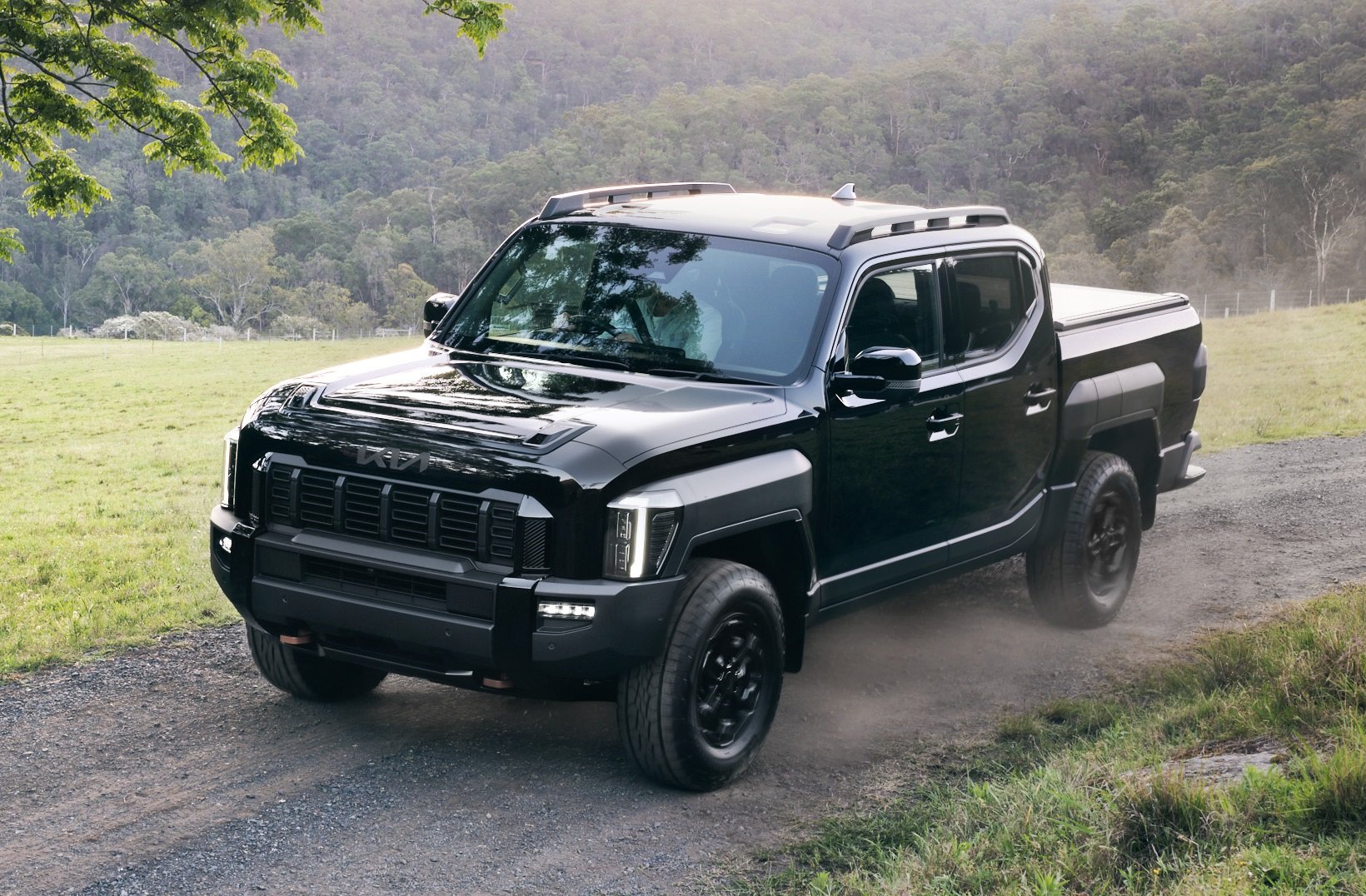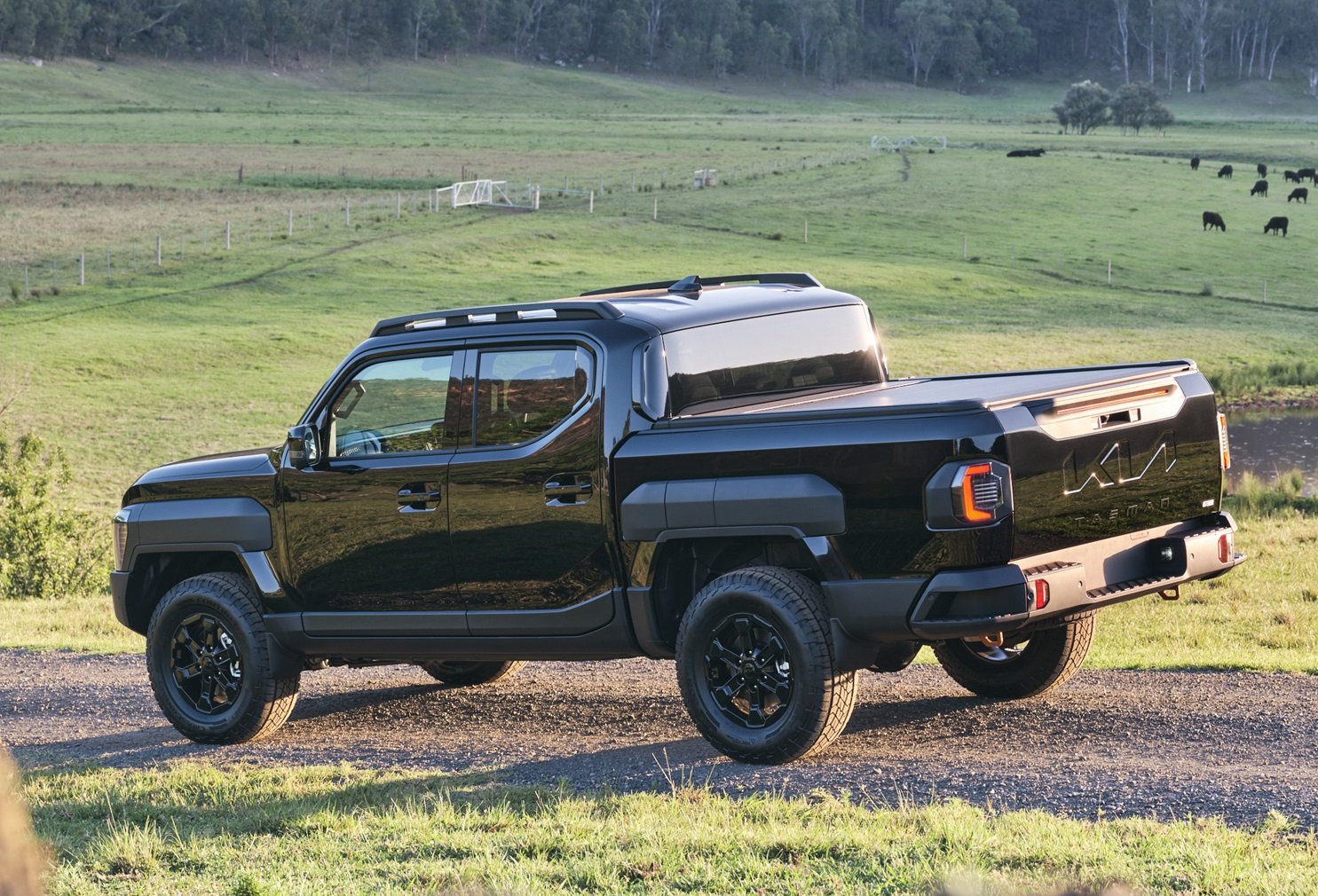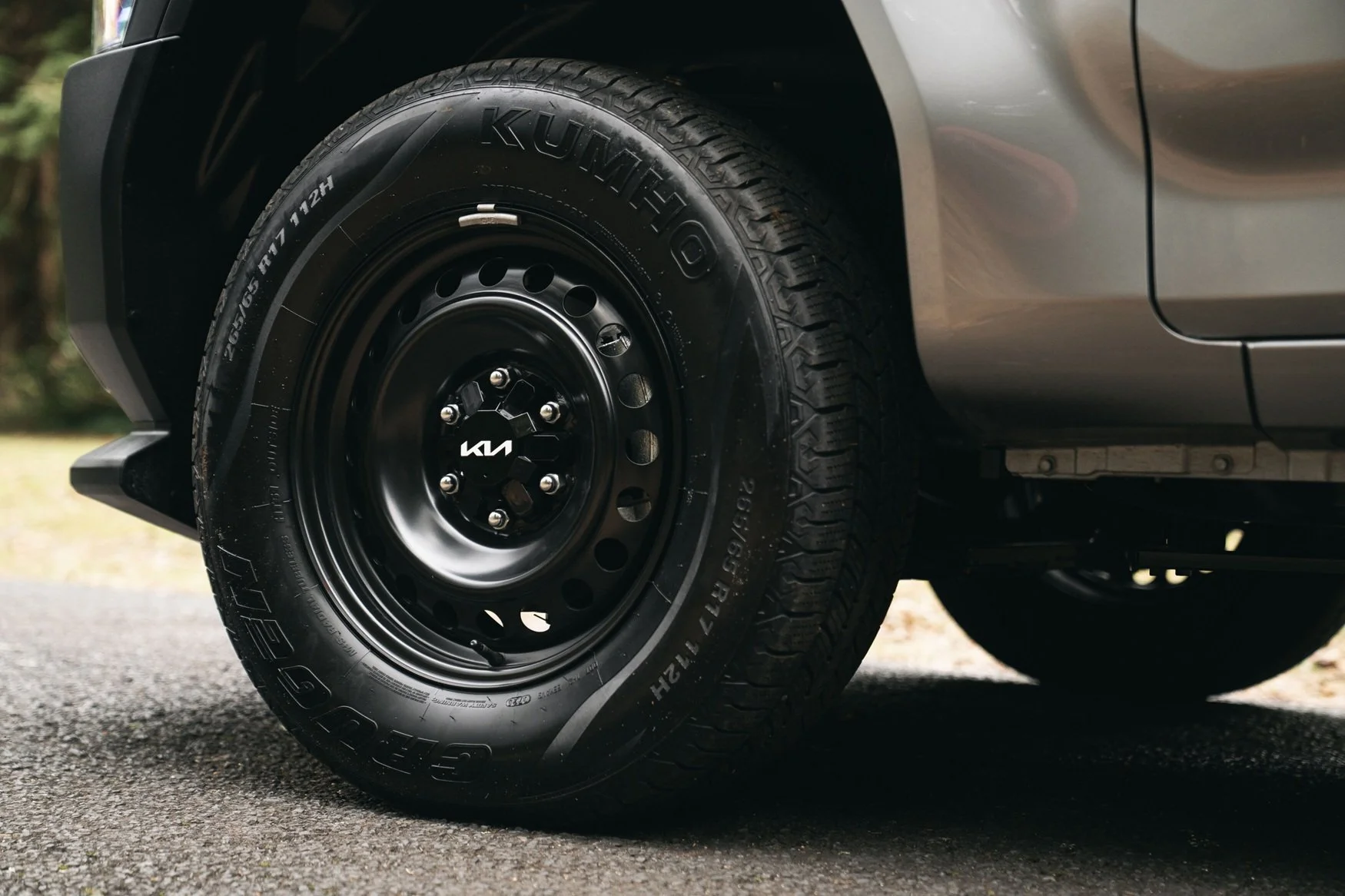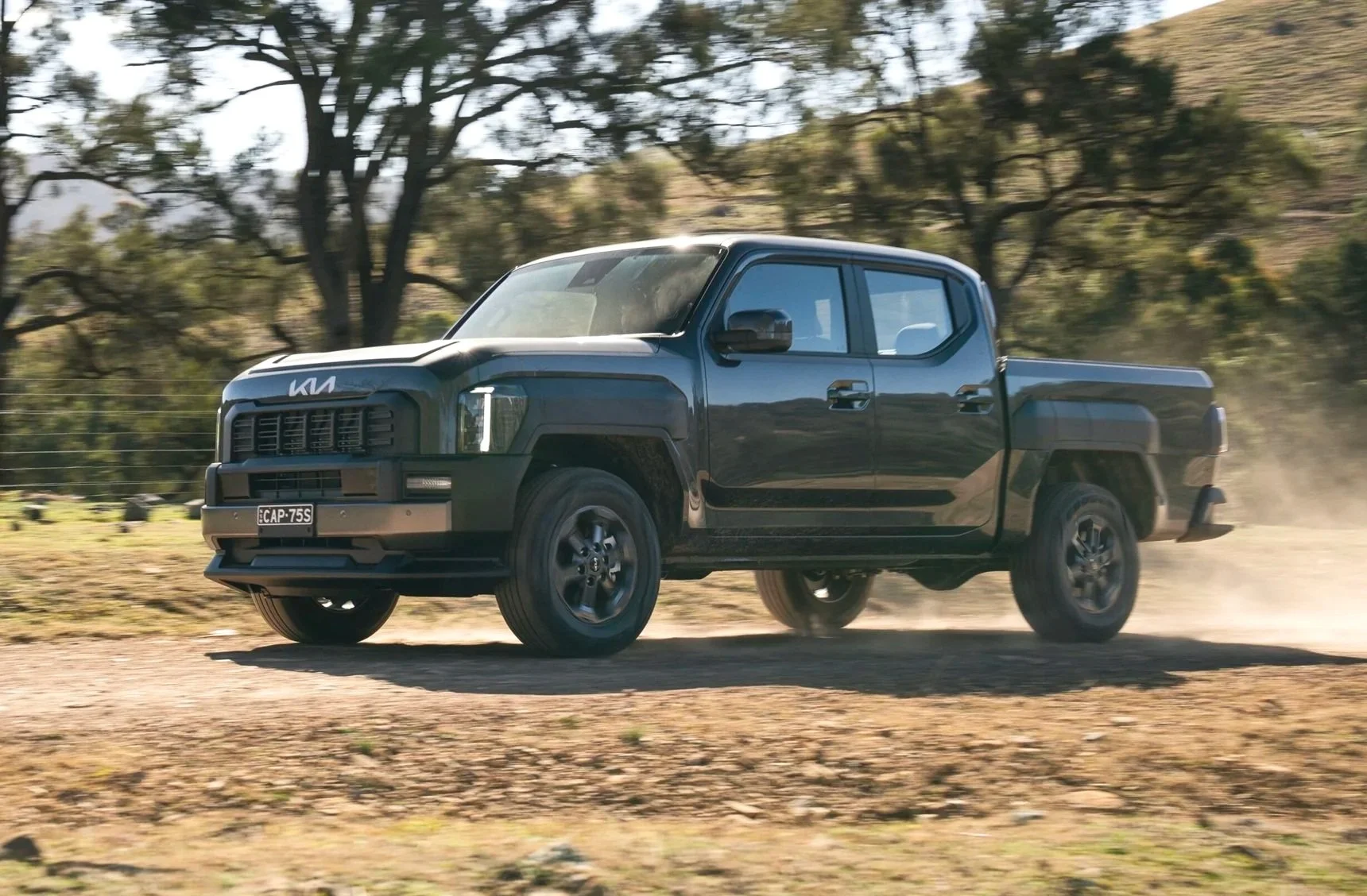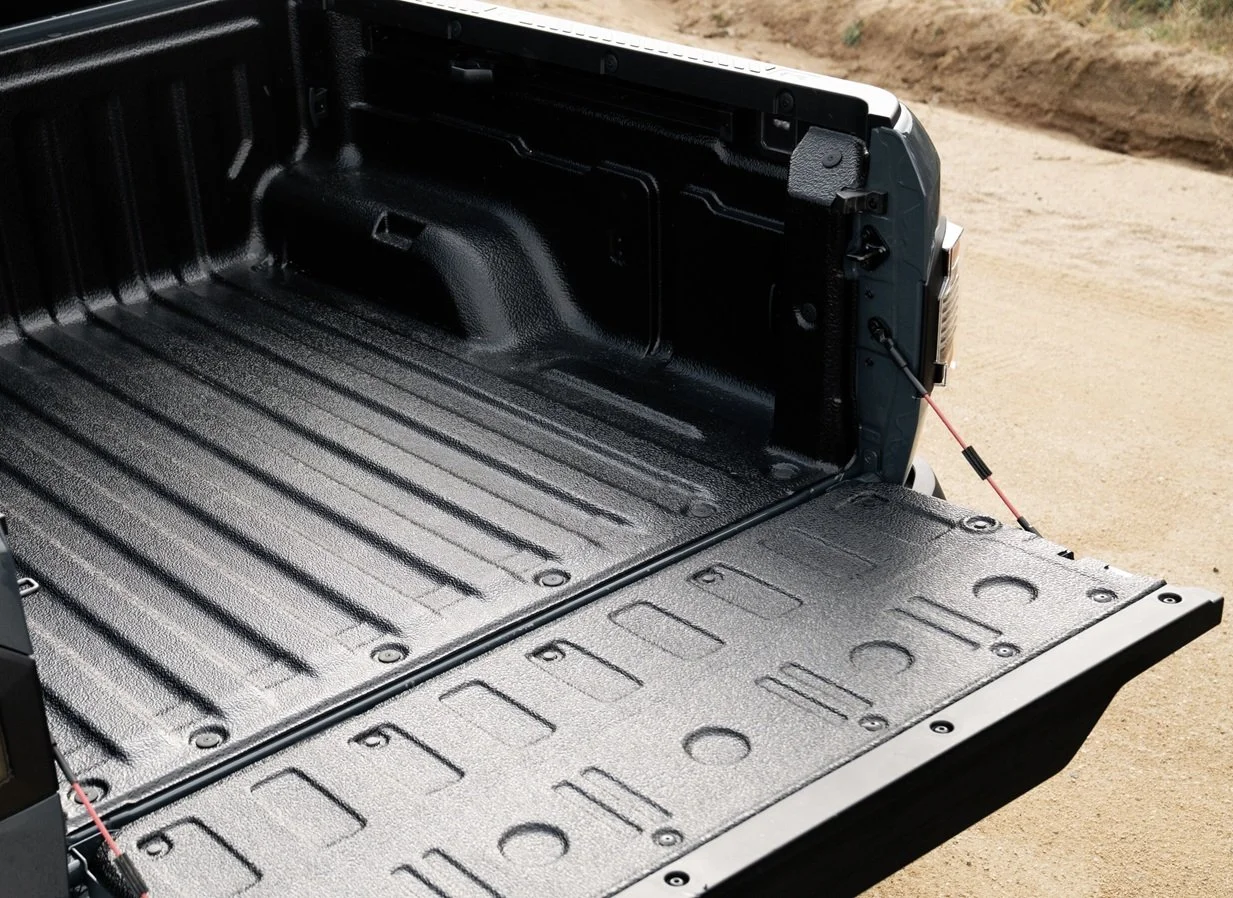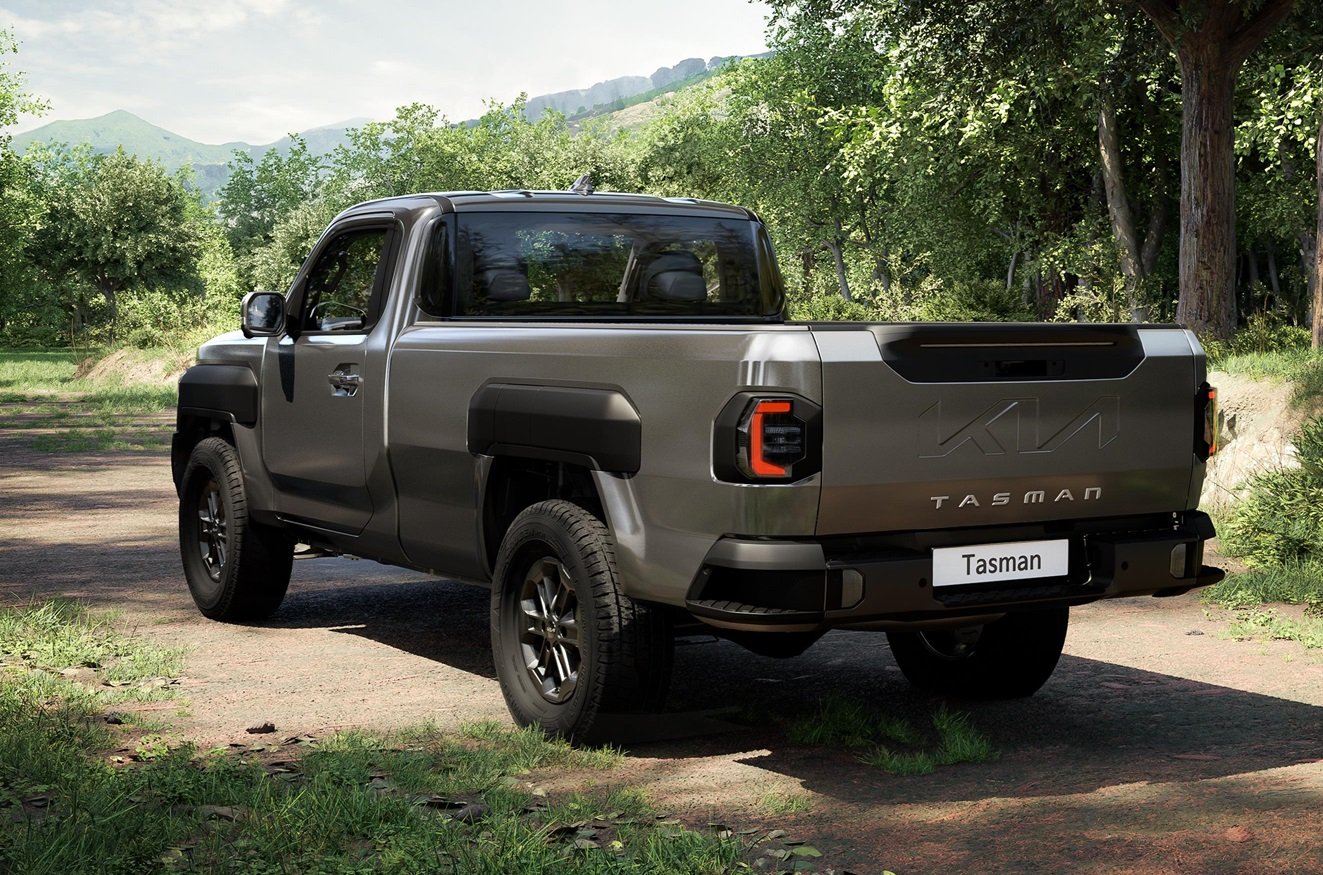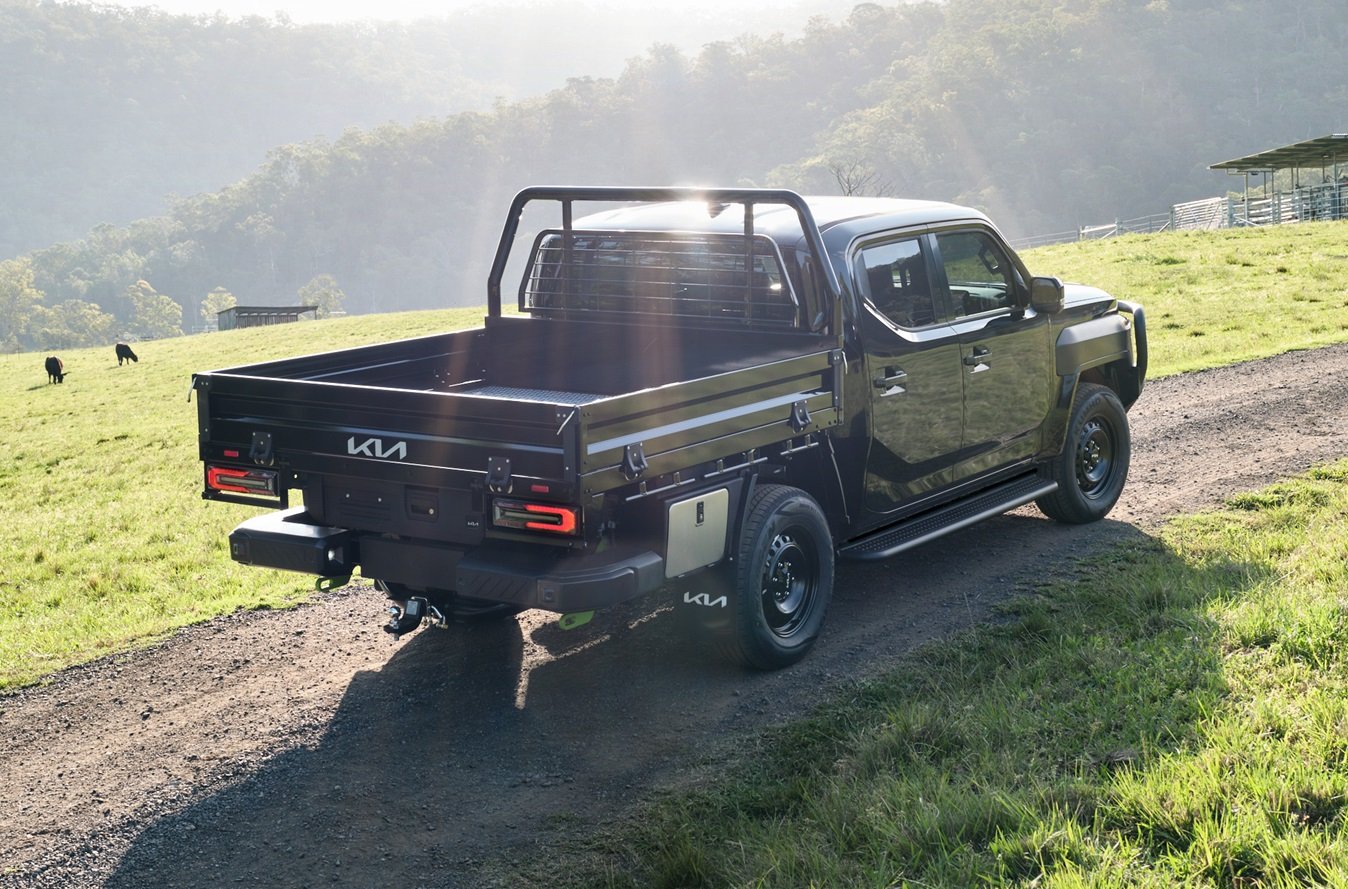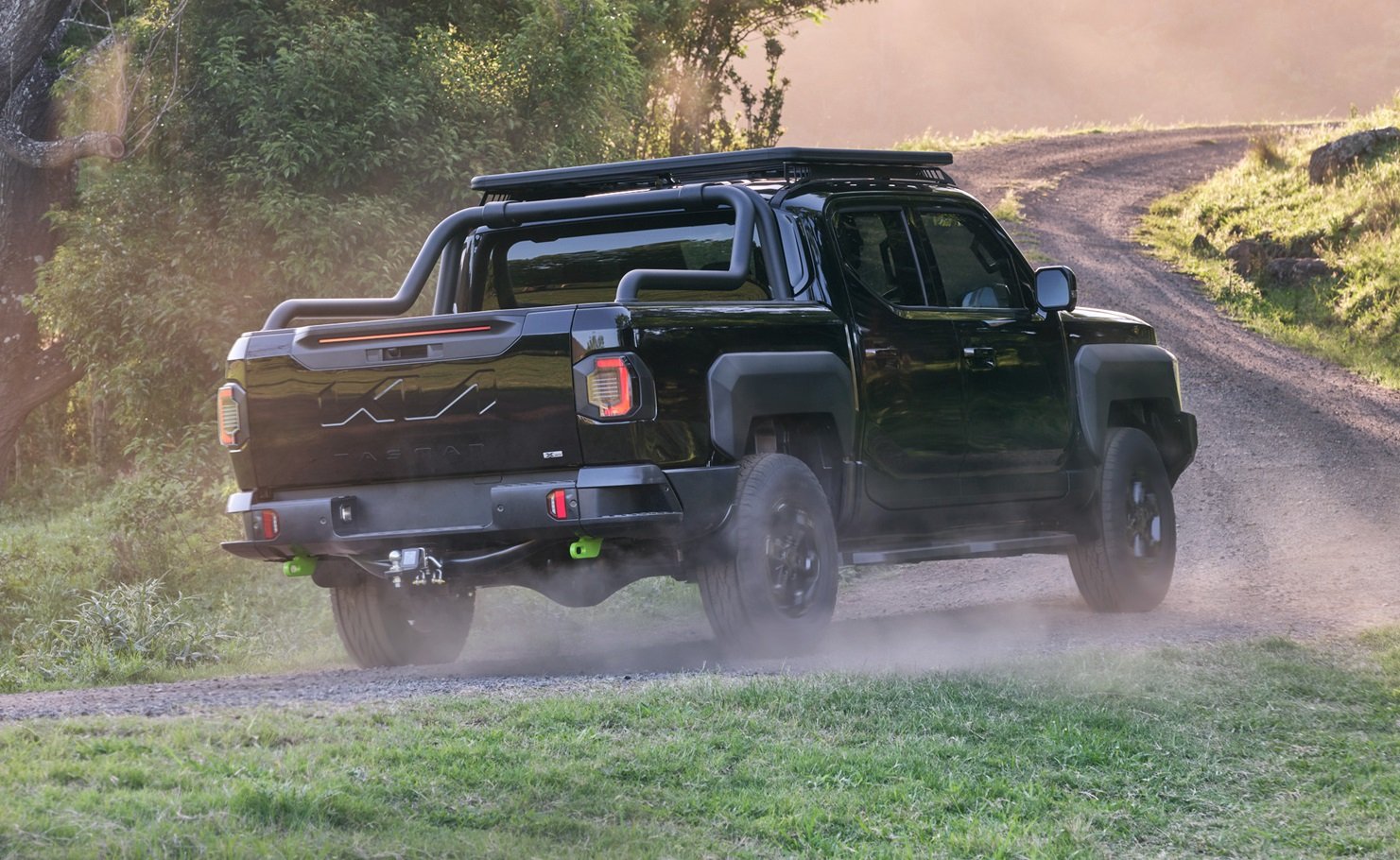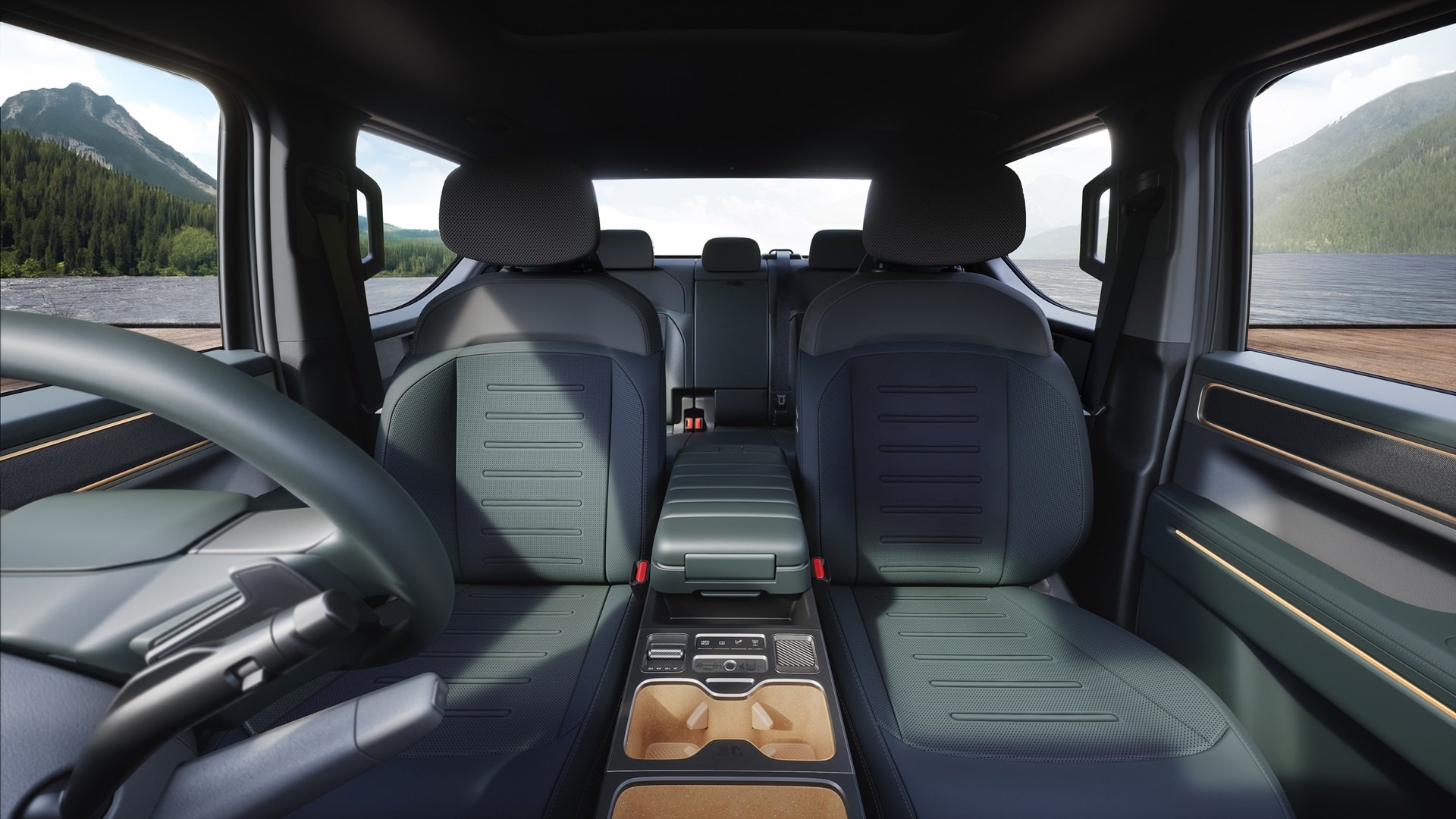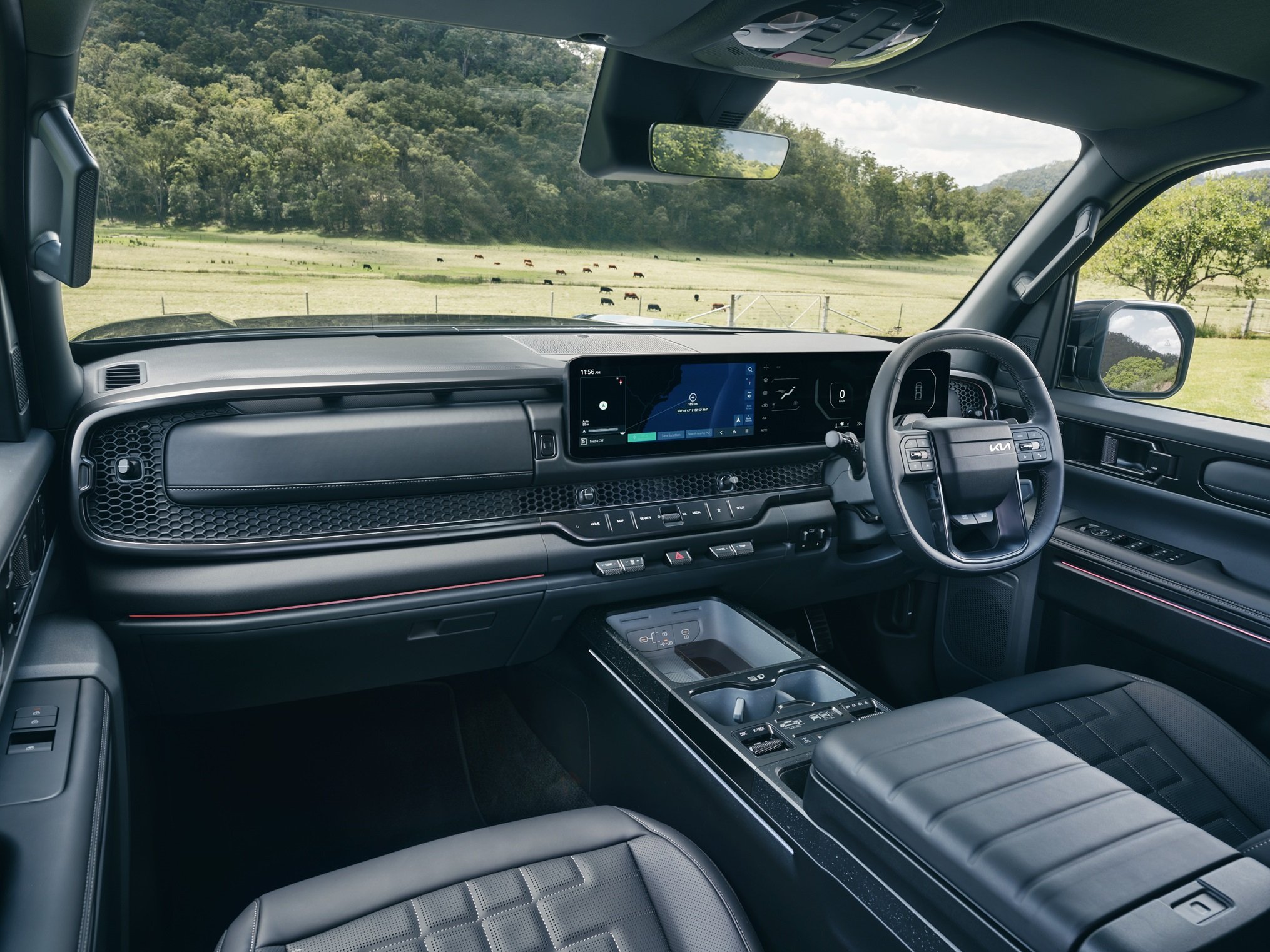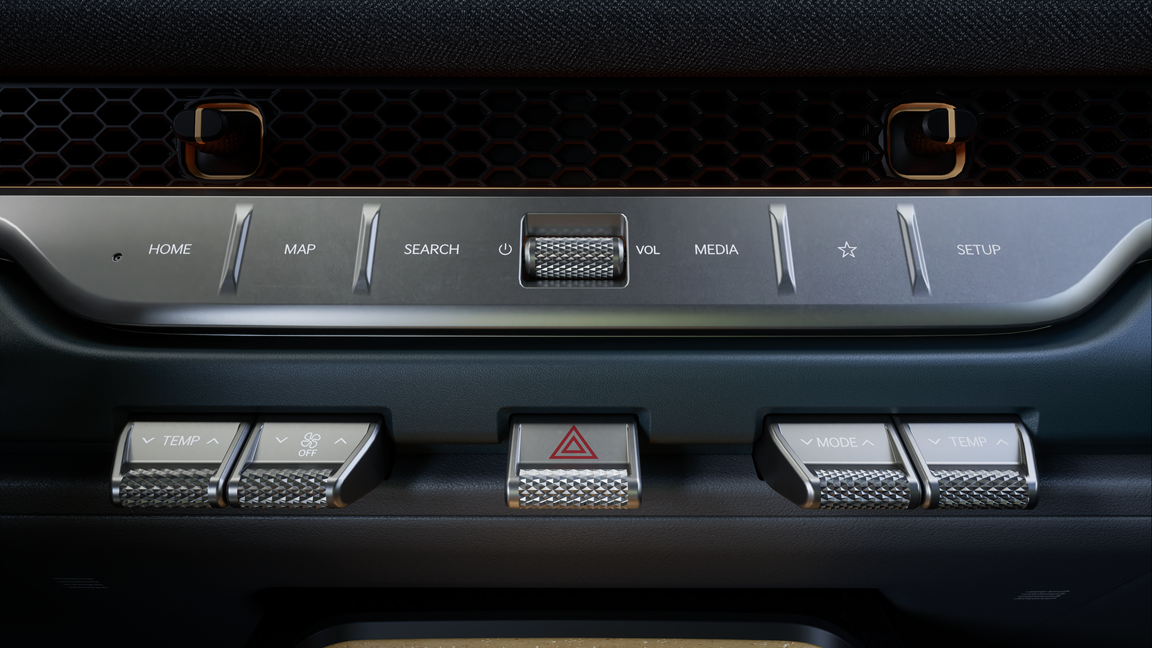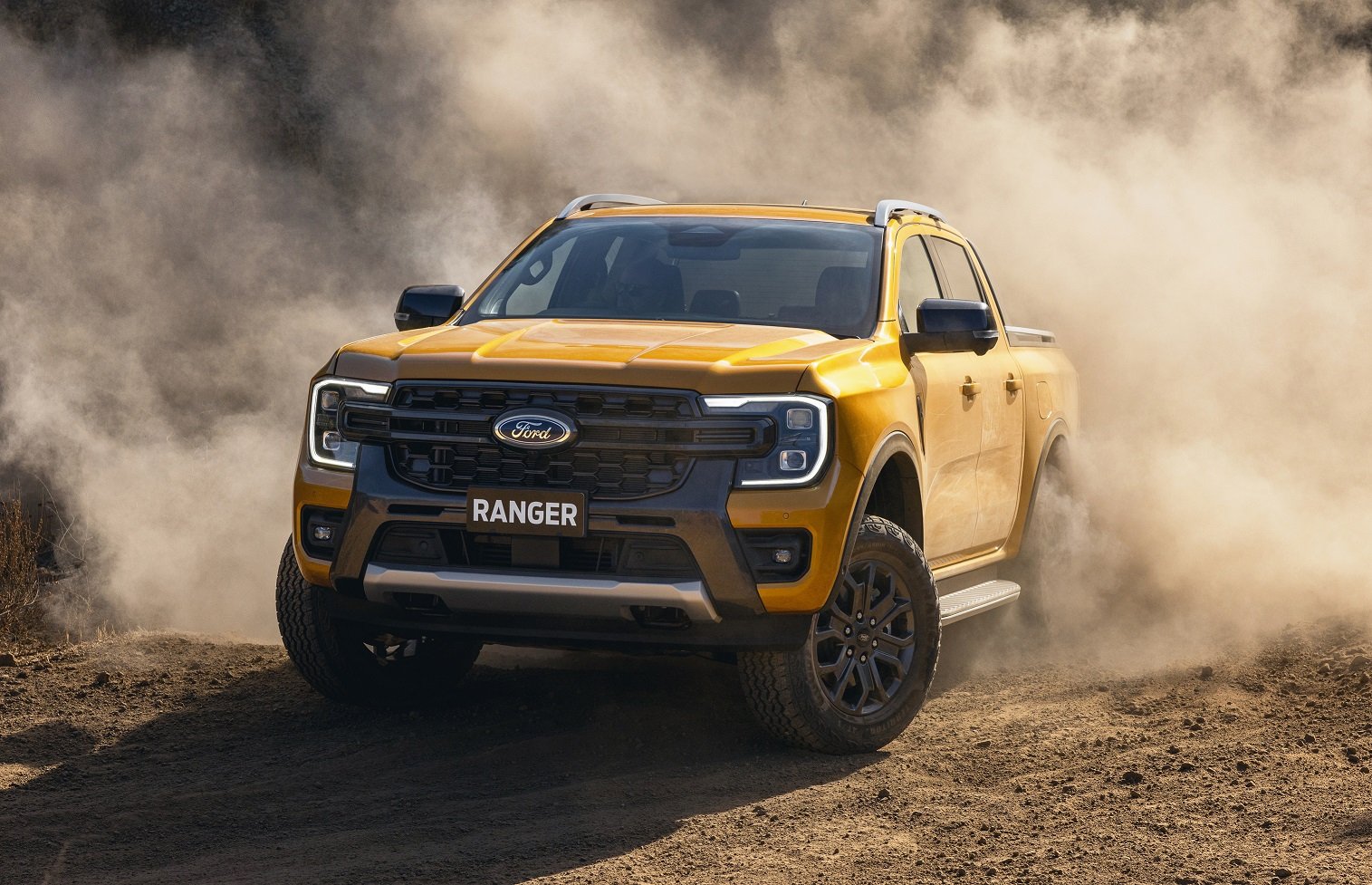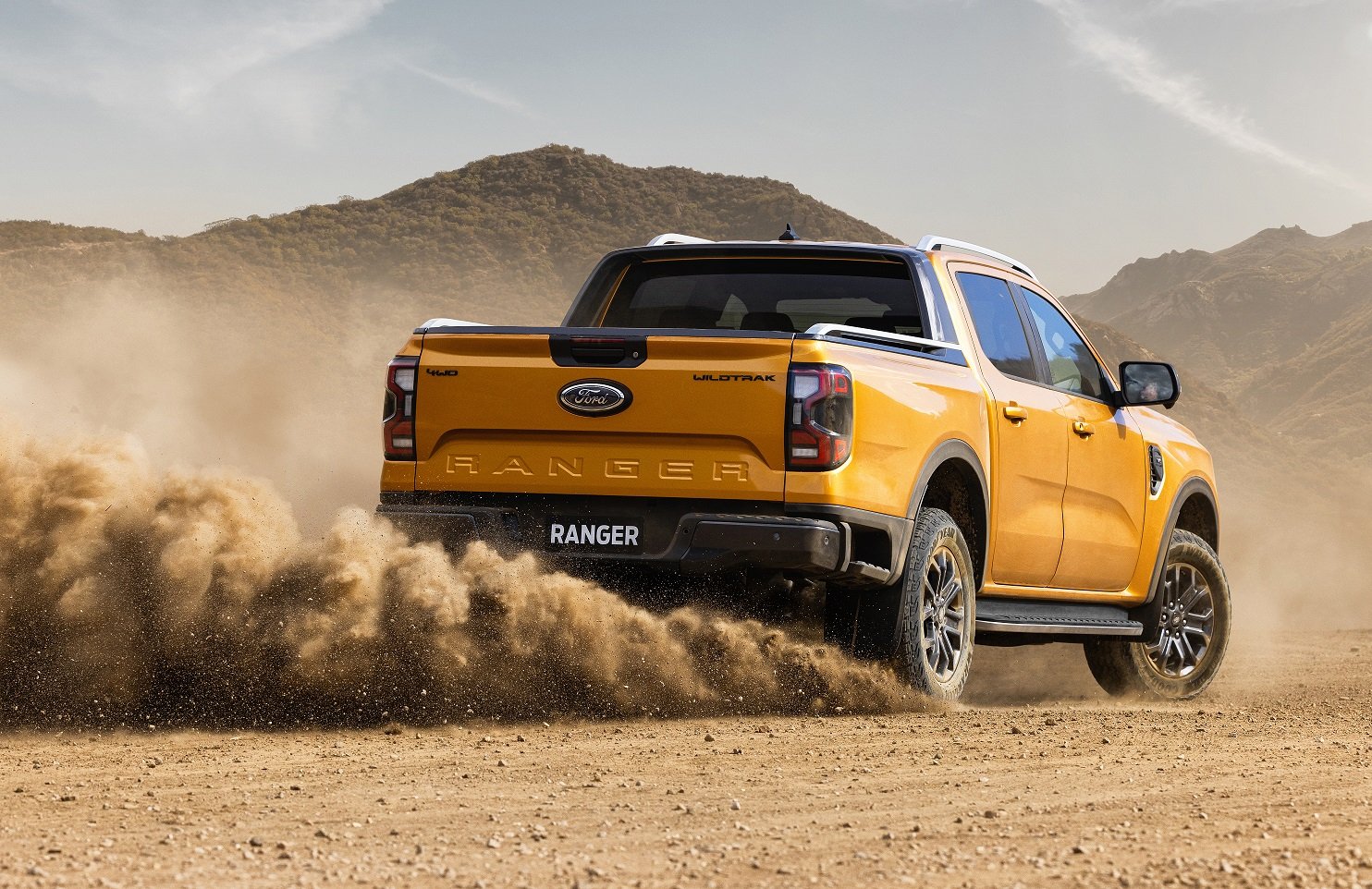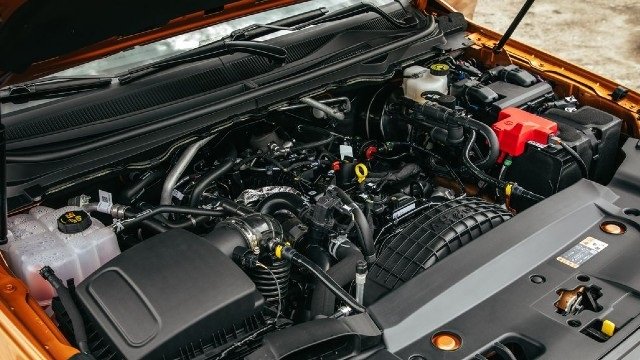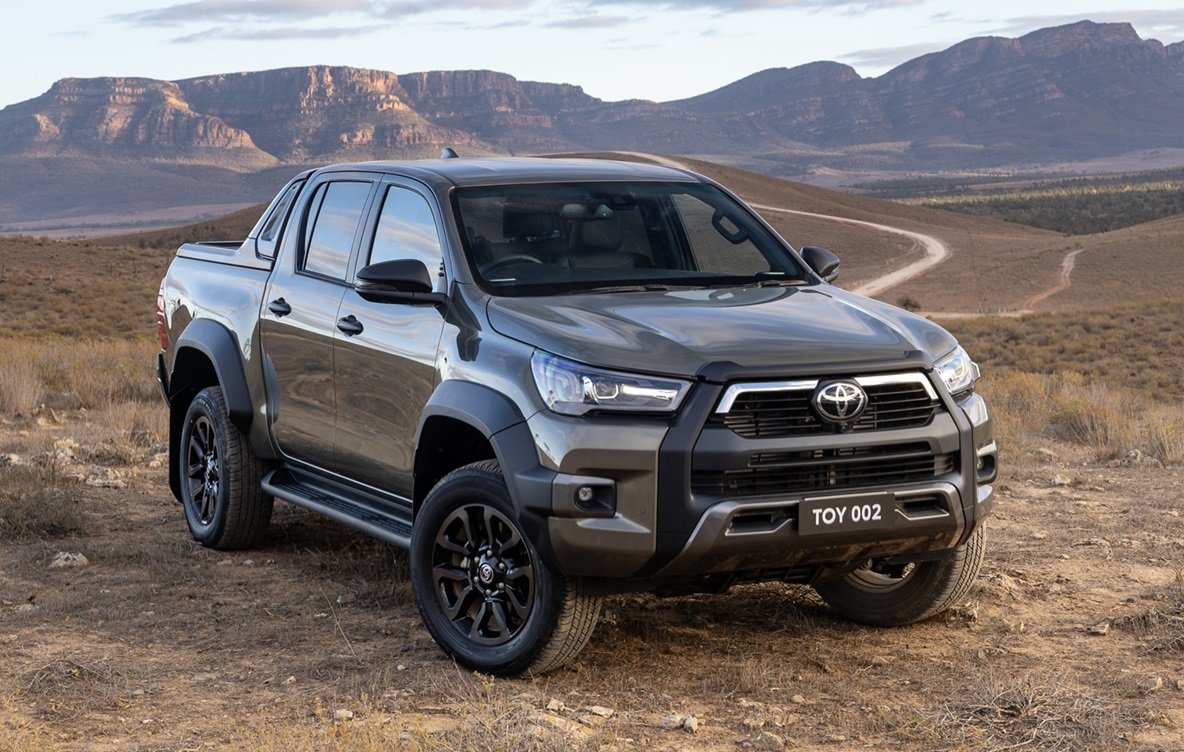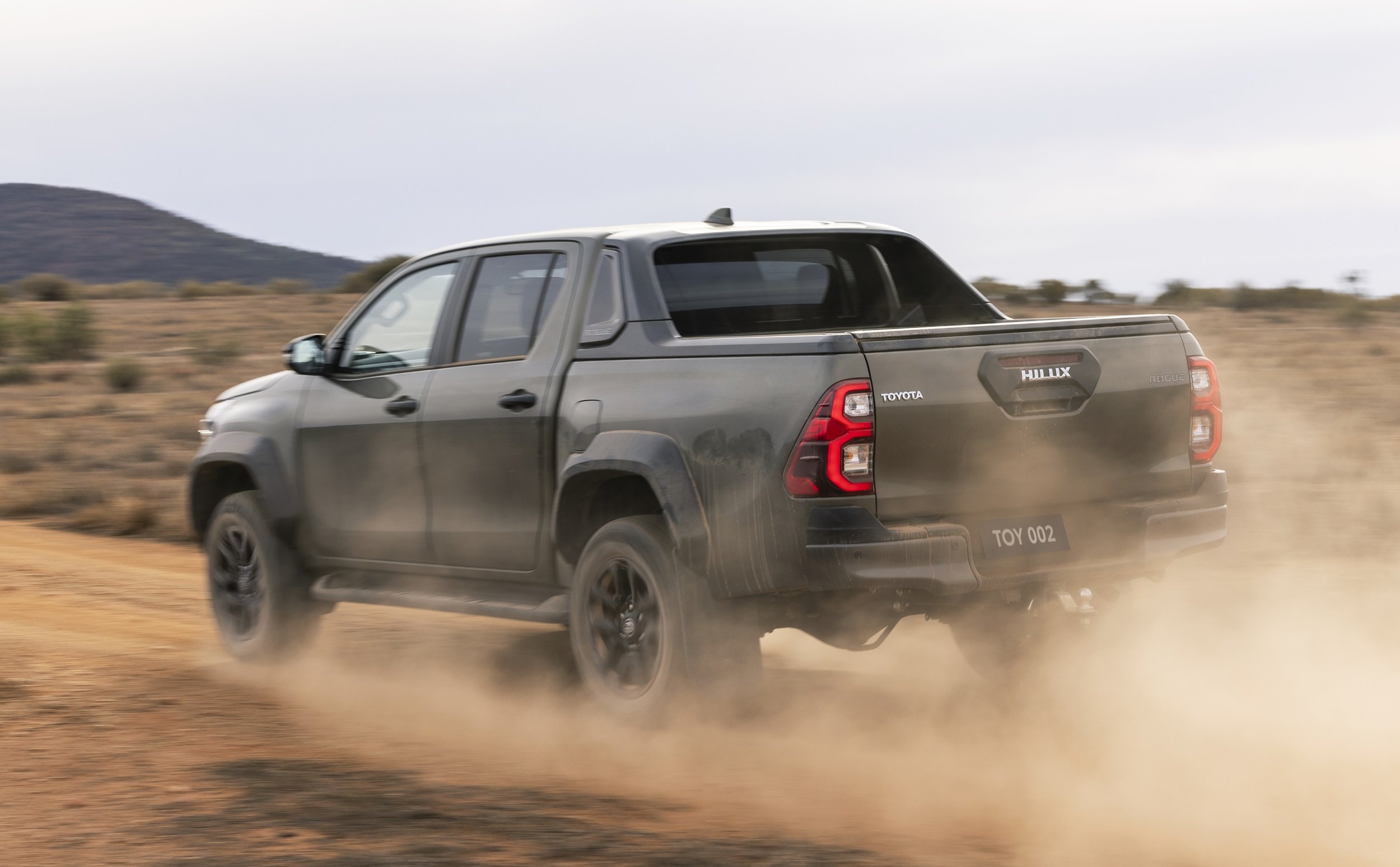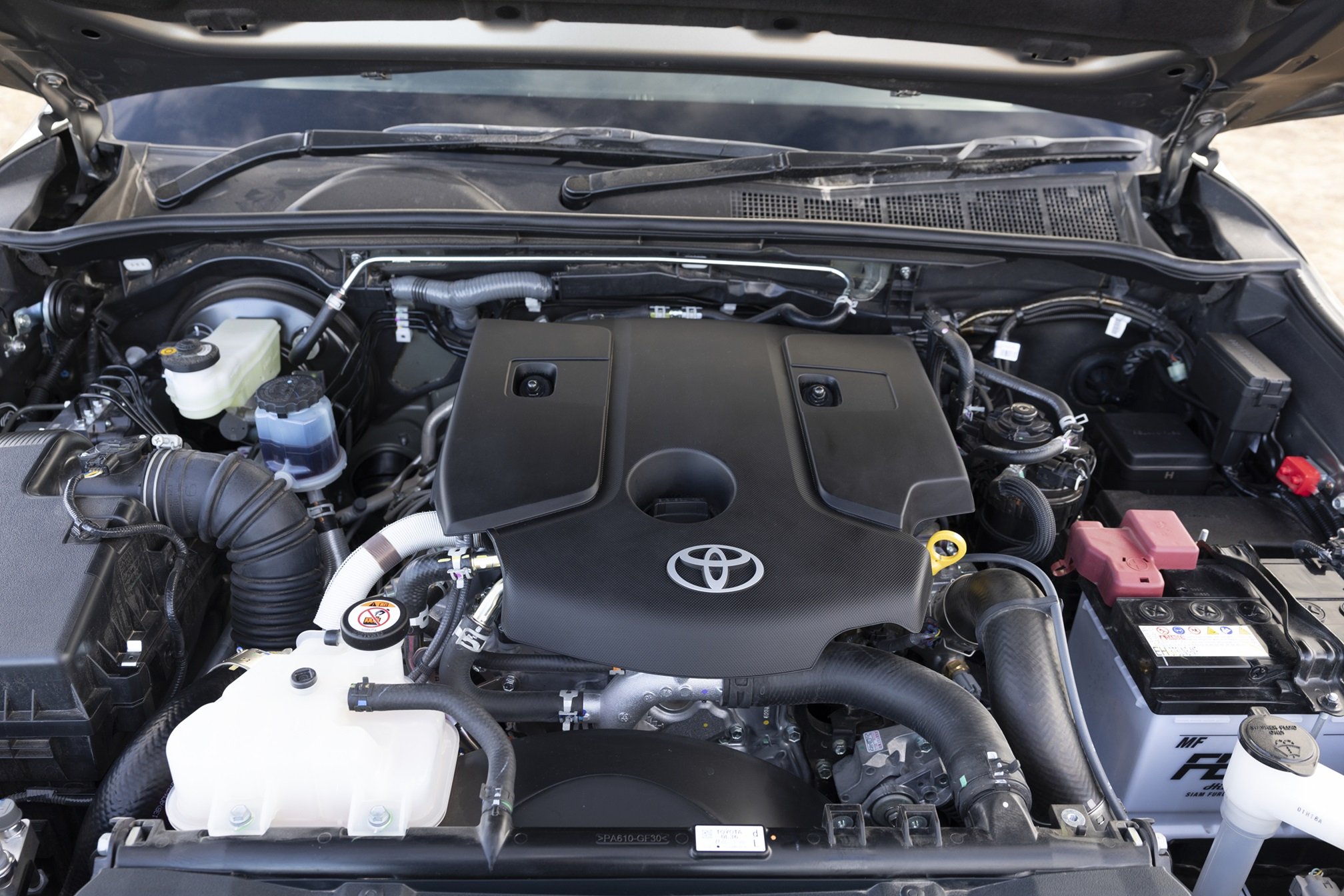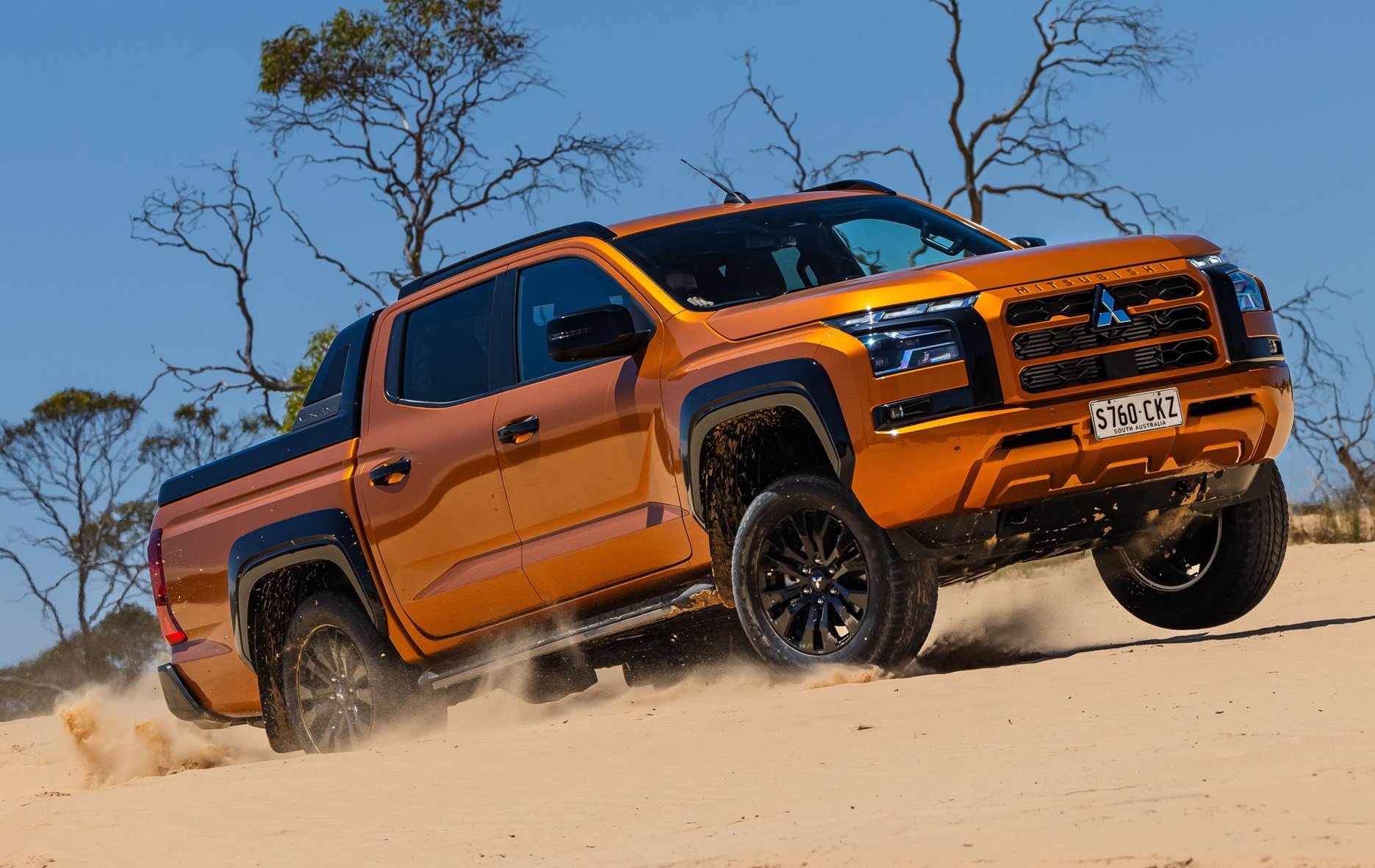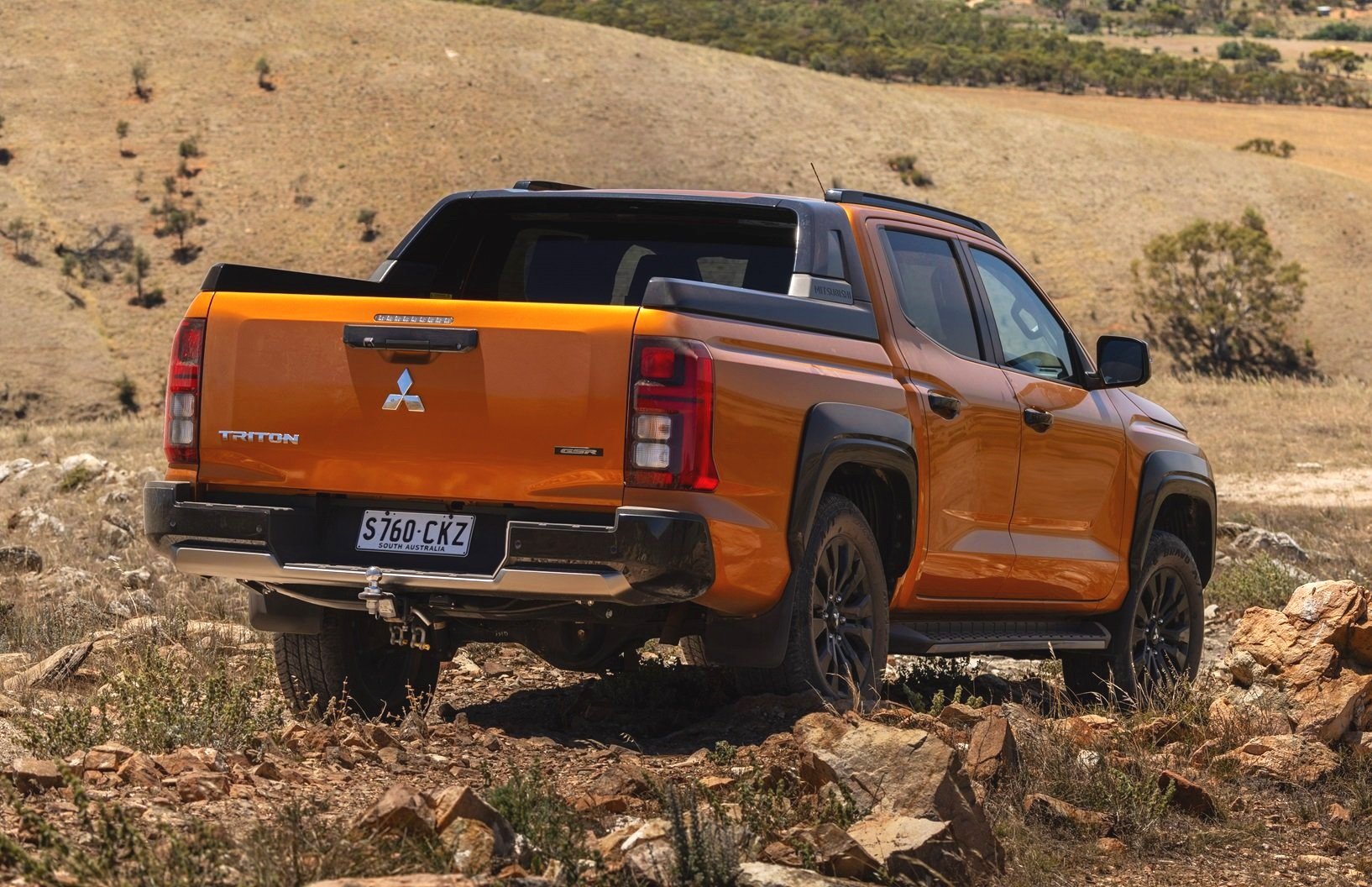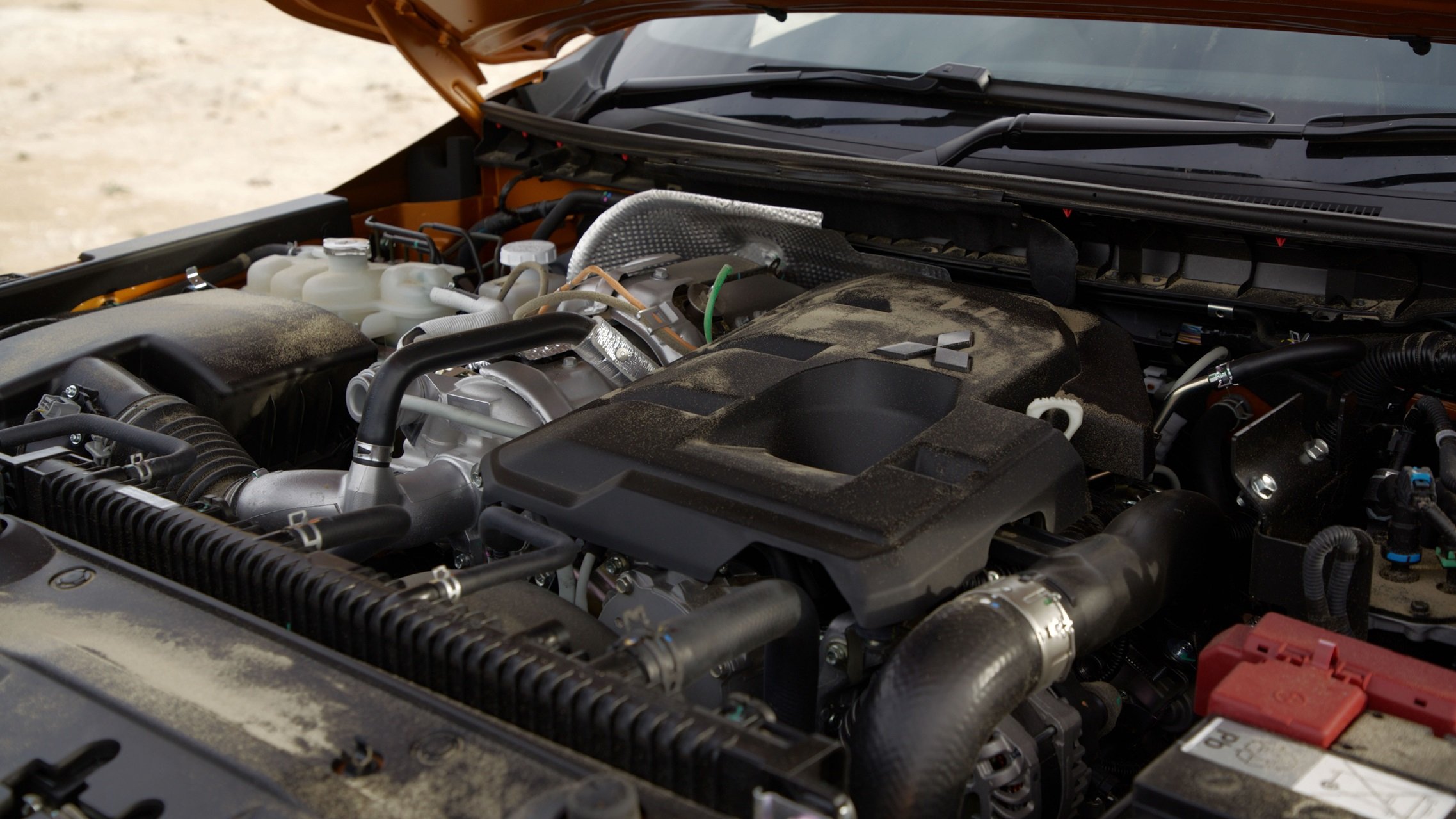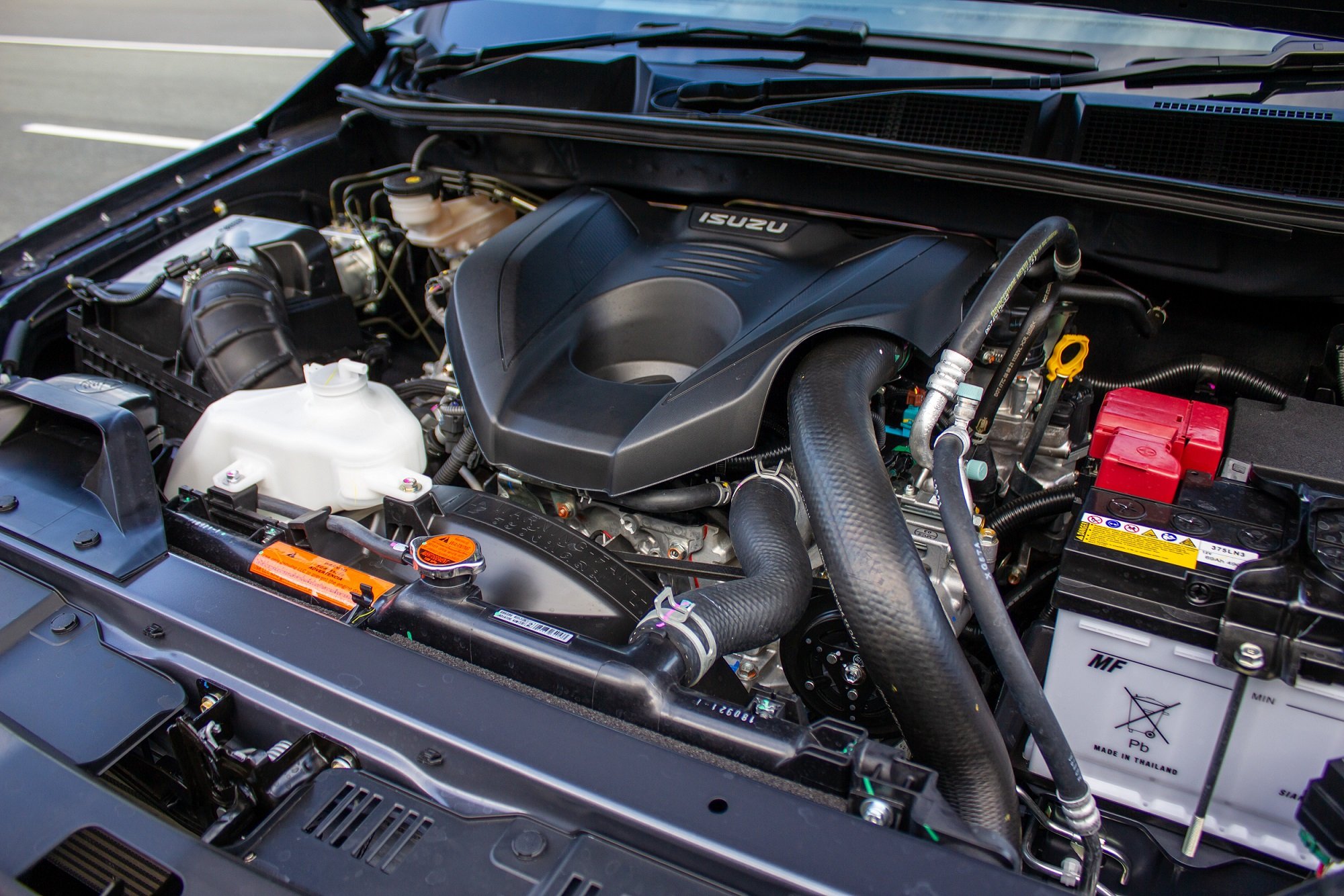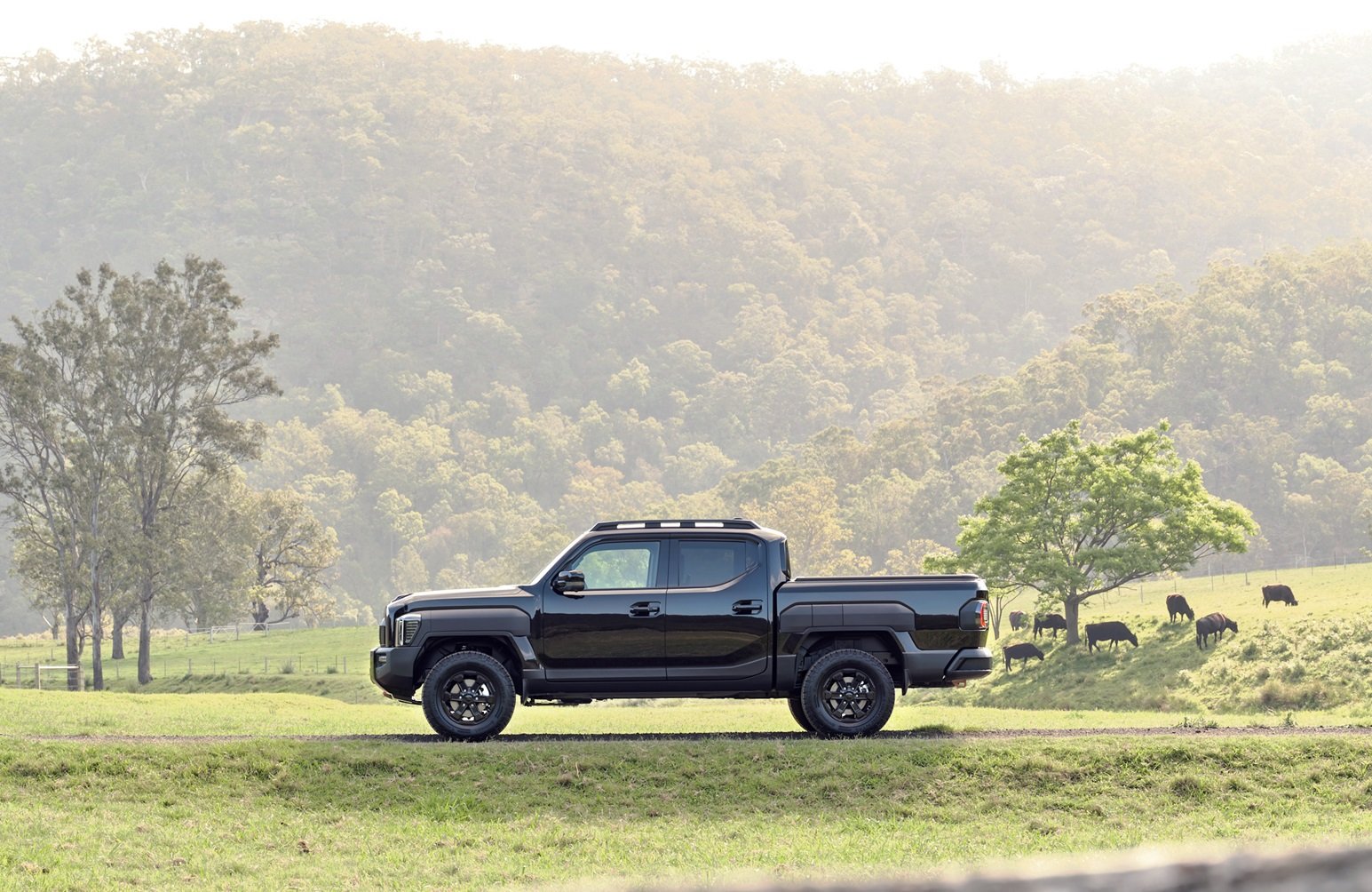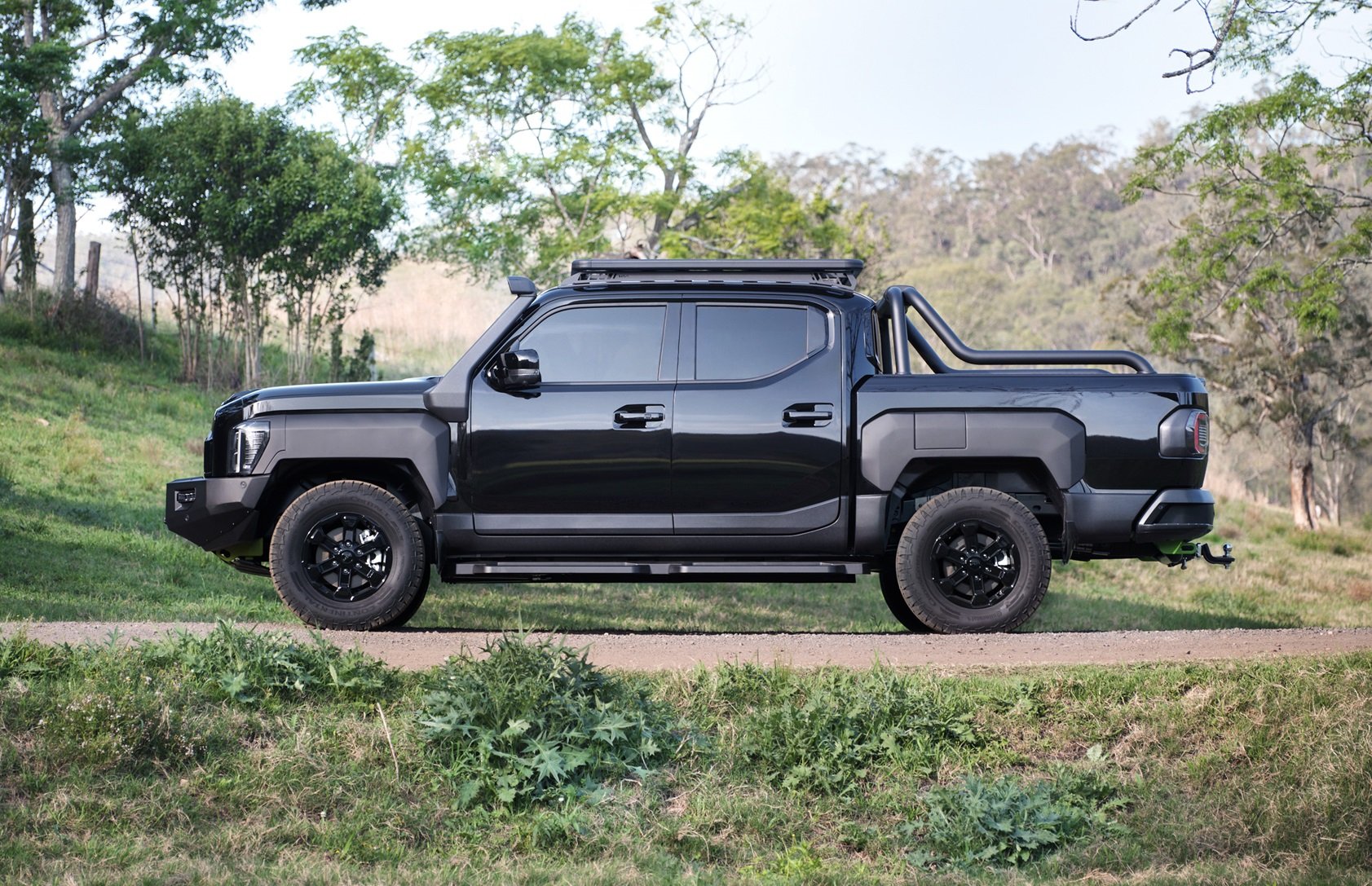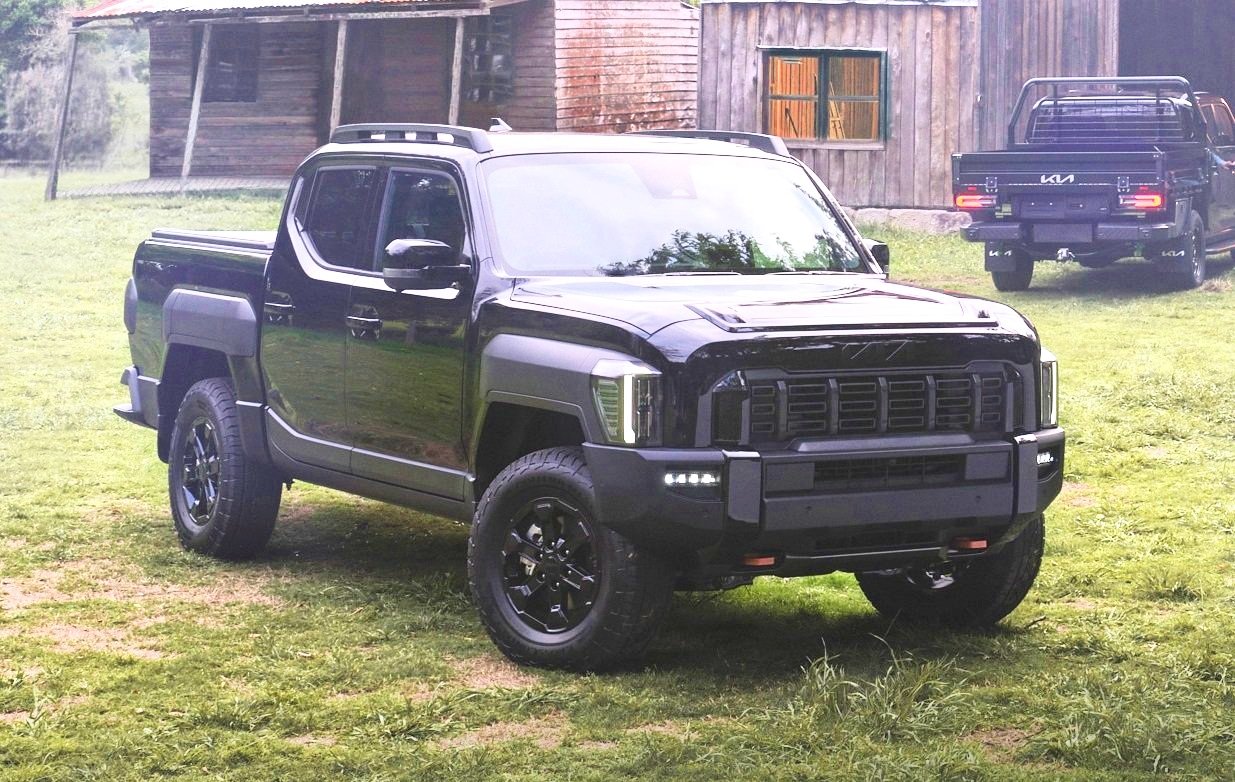Kia Tasman review and buyer’s guide
The all-new Kia Tasman 4X4 dual-cab ute is finally on sale in Australia, offering some compelling value in its lower model grades and some serious off-roading potential in top-spec. Let’s see if it’s a worthy Ranger, Hilux and Triton rival - or a respectable first try.
The Kia Tasman is one of the newest diesel dual-cab utes to hit the Australian market and there’s no shying away from the fact the styling is arresting and the pricing is not as compelling as we might have hoped. But there’s more to Tasman than meets the eye of the beholder.
Utes in the Australian car industry are important because they must serve multiple roles. They have to function as daily workhorses, towing, carrying and generally being capable both off-road, and also be comfortable on-road for families.
To download the full Kia Tasman spec sheet click here >>
You’ve probably heard the mainstream motoring media call the Tasman ‘polarising’ or ‘controversial’ or ‘love/hate’. But that’s just them being afraid to say what they actually think about the way it looks. You might love the design. And let’s be hoenst here, the looks are more important than most ute buyers might be wiling to admit out loud.
Looks are only only one part of the equation, however, because Tasman does also need to offer you more than aesthetically pleasing lines. This report aims to sort the nonsense from the facts so you can make an informed choice - and Tasman does make for a chin-scratching choice between utes you’re already familiar with, and a newcomer from a brand whose good reputation far exceeds the splay-eyed LED headlights.
One of the more compelling aspects to the Tasman was supposed to be the price and in many ways, it is. With a mid-spec Ford Ranger XLT setting you back over $74,000 driveaway, you’d hope the Tasman can grab your attention with the value. But has Kia grown so much that value (once its greatest strength) loses out to profit margin?
Some suggest Tasman wants to ‘take on’ the Ranger and Hilux, but that’s a very naïve idea considering how rightfully popular those vehicles are - and you can include Triton and D-Max in there too.
Happily, a Tasman SX+ does actually make a strong case in the middle of its range, undercutting the Ranger XLT by about $8000.
Now that Tasman has your attention, let’s see what kind of sales Tasman needs to achieve in order to establish itself properly in the Aussie market, and what kind of dimensions you’re looking at with this thing.
The Tasman is an important vehicle for Kia Australia, appealing to the same would-be buyers of Rangers, Hiluxes, Tritons, BT-50 and D-Max. The Mitsubishi, Mazda and Isuzu are the two utes most at risk of losing sales to Tasman and its going to be a popular fleet vehicle, because fleets do make up almost half of all new car sales in Australia.
Ford Ranger and Toyota Hilux are the best-selling vehicles in Australia for very good reasons. They’re reliable, tough, capable and they look appealing - but that’s not necessarily everything a fleet manager needs to consider. They also need the price to be right for what is, effectively, a tool of the trade but in the sense of a company-wide, local council or government department.
Ford Ranger sold nearly 58,000 units in 2024, while Hilux managed just under 46,000 - and they’re going to do these kinds of numbers again in 2025. Ranger at mid-year sits on 26,000 with Hilux on 22,000, and in third place is the D-Max on almost 11,000 units while the BYD Shark sits just behind in fourth just below 10,500 sales. Triton sists in fifth on 8200 sales and this is where Tasman is going to do a lot of damage to the big ute model sales.
Given Tasman is arriving so late to the party, it will not see a full calendar year of sales until 2026. So let’s be clear here: Kia Tasman is emphatically not a threat to Ranger and Hilux just yet. It will skim curious private sales away from other utes in the segment like Triton, BT-50, Amarok and D-Max.
The Tasman runs the Hyundai-Kia 2.2-litre turbo diesel engine we’ve seen in Sorento, Carnival, Hyundai Staria, old Santa Fe and the 8-seat Palisade. It’s been a very successful engine and made up about 80 per cent of sales in Sorento and (old) Santa Fe. Despite what the critics have said, this has been a very reliable powertrain and it makes perfect economic sense to use it. (More on that later.)
The 2.2 might be great in a large 7-seat SUV full of kids and luggage, and sure, it might be fine for towing up to 2.5 tonnes. But what we don’t know yet, because the Tasman doesn’t actually arrive until mid-2025, is whether it can do both of these things at the same time, while overtaking trucks uphill and trawling through town on a 40-degree summer’s day.
We also don’t know if it will be capable of performing the types of low-speed high-load off-roading driving expected from Ranger, Hilux and Triton with bulletproof reliability and durability.
It seems like the only reason to hold out on purchasing that Ranger or Triton or Hilux or BT-50 might be the value-pricing of Tasman.
Let’s start with some honesty about Tasman’s inception and development. This is important so that you understand what Kia has had to achieve up to this point. Starting with the Mitsubishi Triton as a key example because it’s in the same pricing bracket.
When Mitsubishi recently released the Triton in 2024, they had the old Triton as an R&D springboard to launch from. That was more than convenient, it’s a massive cost-saver. It was a platform on which to upgrade to the new one and that really helps because the introduction of any new model is typically also the commencement of R&D on its successor.
In other words, when you do a new model, you’re also starting on its future successor - you’re pre-planning what comes next.
What essentially happens is the R&D process fixes the glaring faults on the current one and incrementally improves it elsewhere for the new version. This is a constant cycle within car companies. In the case of Tasman, things are different.
Kia didn’t have this ute-specific evolutionary beginning. It's not been a completely clean sheet of paper for other utes on the market like Ranger, Hilux, D-Max or Triton, because they all have older models. Tasman has no predecessor.
This means Kia has invested a lot of resources. This Tasman is a full-sized ute that’s longer than a Ranger. That's expensive to do from the ground-up, and impressive that they’ve gotten this far - credit where it’s due. Considering how far Kia has come in the last 20 years, they’ve done well. It’s just a shame it took so long.
Amortizing the R&D into the units they're going to sell is going to pump up the price significantly, or alternatively it will just take a long time to pay off.
Obviously Kia has a huge R&D inventory, and Hyundai/Kia does have a fairly big footprint, from shipping and trucking, to agribusiness and some kind of military section. It’s a surprise they didn’t draw on any of that to make something with more grunt.
They have given Tasman a ladder frame architecture, so they have gotten that part right. But there is so much consumer-based gravitational pull from the big utes from Ford, Toyota, Mitsubishi, Isuzu and Mazda, it’s hard to see how how Kia is going to fair in the sales race. But there is the question of brand reputation to consider.
In the case of most other brands, you’d have to be rational and say, yeah, Kia absolutely does have one of the best reputations for customer support, reliability and technical support. That should go a long way in the ute buying pubic who value reliability and good customer care.
And Kia’s family vehicles are probably some of the best models in the market you can buy: Carnival is awesome, Sorento has everything you could want, hybrid Sportage is better value than RAV4, the Picanto is a brilliant little runabout, and remember how the cops started buying the Stinger over SS Commodore?
FEATURES & PRICING
Tasman is effectively the same price as a Mazda BT-50 or Mitsubishi Triton in that $40,000-75,000 range, and even a little more at the top of the range with the more hardcore off-road versions.
You’ll have the option of choosing a sub-1000kg payload if you’re a fleet buyer (or over 1000kg if you’re a regular private punter), you can also opt in or out of the black wheelarch bulges in favour of body-coloured ones, depending on your tastes. The good thing here is, according to Kia’s pricing structure, it doesn’t affect the price.
Value is probably going to be the underpinning sales advantage here, whereby the top-spec versions need to have more gear to justify the similar pricing to upper-spec models of Ranger, BT-50 and Hilux. And then at the bottom end of the Tasman range, outright price needs to win out against these already-popular models if Kia’s going to compete with them and the Chinese brands like GWM Cannon, LDV T60 and the incoming MG ute.
This could be a great thing for potential Tasman buyers, because if you’ve got a ute with a massive tray, the same or better cabin comfort, and not as much power as your rivals, a significant price advantage has got to be the biggest appeal here. So you need to ask yourself if the pricing is justified here, and does Kia have a better reputation for customer support than the likes of Ford, Toyota, Mazda, GWM or LDV. Answer: yes.
There is Kia’s typical model grade line-up for the dual-cab, starting with the Tasman S (the base model), then the SX and SX+ as the mid-spec value option, before stepping up to X-Line and X-Pro as the top-spec trophy versions.
Pricing looks like this:
TASMAN S | 4X2 dual-cab | $46,500 driveaway approx.
TASMAN S | 4X4 dual-cab | $53,900 driveaway approx.
Starts with:
Apple CarPlay & Android Auto (both wireless)
Wireless smartphone charging x 1
Integrated panoramic display: 12.3-inch digital driver’s display, 5-inch HVAC screen, 12.3-inch infotainment screen)
Satnav, DAB+ radio, 6-speaker stereo
Dual-zone climate control
Cloth seats, standard centre console, 2 x USB-C ports (front) + 2 x USB-C ports (rear)
TBC: Tyre pressure monitoring, auto rain-sensing wipers
Front & rear parking sensors, blindspot monitoring, rearview camera (dual-cab only)
Electrically adjusted manually-folding heated door mirrors, manually adjusted seats
Auto emergency braking, adaptive cruise control, rear cross-traffic alert, lane-keeping, forward collision alert
17-inch back steel wheels with full-size spare
Drive mode selection (sport, normal, eco), 4WD system (2H, 4A, 4H, 4L) incl. rear diff lock
Tailgate with Lift Assistance (dual-cab only), rear corner load steps, driver’s side wheelarch storage box
LED headlights, foglamps and daytime running lights, halogen taillights
Rear air vents, 2 x ISOFix point pairs, dual zip-up seat pockets, extendable front sunvisors
LED Headlights (MFR Type), daytime running lights (halogen TBC)
Integrated trailer brake controller, trailer sway control
Smart key with push-button start
Rear bumper steps (dual-cab only)
Kia Connect with OTA
LED Interior Lights
Row 2 under-seat storage
TASMAN SX | 4X4 dual-cab | $58,500 driveaway approx.
adds:
Wireless smartphone charging x 2
18-inch black alloys with full-size spare
Assisted tailgate (standard ‘Tasman’ badging)
LED headlights, foglamps, DRLS and taillights, LED puddle lamps
Electric folding side mirrors, electrically adjusted front seats (TBC)
17-inch alloy wheels (full size spare)
Terrain Mode: Snow, Sand, Mud
Safety power window – 1st Row
Inbuilt Satellite Navigation
Highway driving assist (steering assistance, lane-centring - TBC)
Adaptive cruise control - navigation based
TASMAN SX+ | 4X4 dual-cab | $66,500 driveaway approx.
adds:
18-inch alloy wheels (full size spare)
Wireless charging pad (single)
Cloth + artificial leather seats
LED fog lights
Row 2 air vents
Bedliner
Ambient mood lighting
2 x 240V power outlets (tub & behind centre console)
TASMAN X-Line | 4X4 dual-cab | $71,000 driveaway approx.
adds:
Column-type shifter (E-SBW)
Paddle shifters
Privacy glass
Roof rails – Bridge type
2nd row armrest
Wireless charger (double)
Rear fender flare storage*
RSPA
Parking Collision Avoidance Assist
Surround View Monitor
Blind-spot View Monitor
LED Headlights (projection Type)
Heated seats – 1st row
Artificial leather appointed seats
Powered driver seat – 8-way
2nd row slide/reclining seats
TASMAN X-Pro | 4X4 dual-cab | $78,000 driveaway approx.
And then to come out blazing, we might see a bunch of off-road and towing specific equipment, plus additional passenger comfort gear, such as:
17-inch (down from 18s) black alloy wheels with all-terrain tyres
Electronic locking differential with on/off switch
X-Trek Mode
Terrain Mode: Snow, Sand, Mud, Rock
Ground View Monitor
Premium Sound System (Harmon Kardon)
Fuel tank undercover protection
Heated steering wheel
Ambient Mood Lighting (Full)
Heated seats – 2nd row
Ventilated seats – 1st row
Powered passenger seat – 8-way
Integrated Memory System
Sunroof
Off-road data display (steering direction, steering angle, oil levels, etc)
FUNCTIONALITY
Tasman does legitimately get to brag about having one of the biggest tray in the dual-cab segment, but that depends on which measurement is most important to you.
Tasman’s tray is 1512mm long, a figures which is better than the Ford Ranger. But Tasman’s tray length is also 43mm (2 per cent) shorter than Triton (second longest at 1555mm), and 58mm shorter than a Hilux dual-cab SR5 at 1570mm. You have to ask yourself: does that matter, realistically?
It’s not always length that matters though, because width might be more pertinent. Tasman’s tray being 1572mm at its widest and 1186mm between the wheelarches. This is also better (by 52mm) than a Ranger at 1520mm. Is 52mm negligible or precious extra space?
Typically if you are loading something that takes up a lot of space in the tray, you’ll often have accoutrement that needs to go with said thing. Something like a pallet that needs strapping down might have a tool box or various implements. Ty[pically if they’re quite long you often have the primary cargo filling the tray and be left with nowhere to ut the additional things.
Farmers might shove a hay bale in the tray which takes up almost the entire space, but then there’s limited space to put the pitchfork or rake safely without it bouncing out. Those extra few millimetres can mean laying the fork down in the bed rather than it dangling partially out the side of the tray.
So Tasman has a tray that is wider than it is long, and yet the whole vehicle is a fraction longer overall than Ranger. That’s a big box out the back.
But what’s perhaps more important here is that the 1186mm between the wheelarches is 31mm (just 3.1 cm) narrower than a Ranger at 1217mm. Despite this loss to Ranger, it does still mean that a 1165mm-squared Chep pallet will fit between those arches.
But you will have to reserve the aft-section of the tray for any Euro pallet where the 1200 x 800 dimensions will fit. A Euro pallet won’t fit between the wheelarches on Tasman - unless the tray dimensions we’ve seen so far change. Otherwise, it seems it will fit rearward of the wheelarches, which is going to compromise the handling.
You could also get a Euro pallet in forward of the wheelarches in a single-cab version, although specific dimensions for the single-cab are yet to be pubolished.
Tasman does have the segment-leading tub depth however, at 540mm (with the tub liner), which is 85mm deeper than the Ranger at 525mm. That’s a 2 per cent advantage when it comes to actually keeping your payload inside the vehicle’s perimeter.
If you ever have to deliver mulch, or sand, or soil, or gravel - whatever it is, it’s actually going to stay inside the tub and will be less likely to blow away on the freeway.
This same advantage applies to tools and equipment, not just to having them stay in the vehicle and making them less likely to bounce out, but it also means the tub wall itself is higher, meaning it’s much harder to reach in (and steal your stuff) when standing on the road or ground beside the vehicle.
Kia claims a maximum tray volume of 1173 litres for the SX+, X-Line and X-Pro.
The ultimate maximum payload of 1124kg is available with the S (4x2), and drops to 1025kg for the S 4x4, SX and SX+. Going for the X-Line will mean 1027kg of max payload or 1013 for the X-Pro.
What’s really important to understand here is that these maximum payload figures aren’t meant to be an endorsement for pushing the load carrying capabilities to the limit at every opportunity. These figures are meant to be viewed as a working load limit - a safety margin between what you need to carry and what the vehicle is capable of before being overloaded.
What’s great about these numbers in the Tasman is that if you put 800kg of payload in the back of an SX, for example, you’re at 78 per cent of the vehicle’s working load limit. So you have a 22 per cent margin for safety, costing roughly $57,000.
At $58,600, the Mazda BT-50 XTR has a payload of 988kg, meaning that same 800kg payload puts you at 81 per cent of the vehicle’s working load limit, leaving you with a 19 per cent margin for safety. A Ranger XLS is $61K and has about the same safety margin as the BT (and also beaten by the Tasman). This is worth thinking about if you do a lot of load-carrying and plan to avoid ending up on the roof.
You get a couple of integrated footholds carved into the corners of the rear bumper, and it seems you can probably get a proper 6-footer’s workboot in there (as opposed to some car designer’s trendy loafer or skate shoe).
There’s also hidden storage behind the driver’s side drop-down wheelarch which is bottom-hinged to double as a light-duty flat surface, limited to 6kg of load. It’s certainly not a workbench.
You’ll also find generous storage space under the rear seat as well, just like a Ranger (but costing less), and the tailgate is damped on the SX variant up.
Then up top on the roof, you’ve got a maximum weight limit of 100kg.
So hypothetically, if you decided to go for the X-Line where you get the factory roof rails, you’ll notionally get 100kg of maximum payload on there. Therefore, because you’ll need to fork out a few hundred on an aftermarket set of roof racks on the S, SX or SX+, you’ll have to take their weight from the 100kg limit.
You’ll just have to wait until the aftermarket has a roof rack system available. Just make sure you claim them on your tax return.
ENGINE
The engine has been one of Hyundai/Kia’s best engines, the 2.2-litre turbo-diesel running in Carnival, Staria, Santa Fe, Sorento and Palisade. But it is about 15 years old now.
It’s now putting out 151 kilowatts (which is the same as current Triton), with 441Nm of torque available. Some have already begun criticising its lack of torque (low-RPM power) for towing and load-hauling. But it’s just 9kW shy of the Isuzu D-Max and Mazda BT-50, both of which are apparently quite capable of towing 3.5 tonnes according to the mainstream motoring media.
Certainly it’s lacking the 184kW of the V6 bi-turbo diesel Ranger with its 600Nm of torque, and yet nobody seems to scold the D-Max for lacking grunt. What does this mean for you? Tasman is probably going to be quite decent in terms of offering punch, it’s just not going to have the same kick as a Ranger. It’ll be closer to Triton or Mazda BT-50 for power - and that’s reasonable.
It is more efficient, making almost the same amount of power with 600 cubic-centimetres less capacity. We know the exact revs at which the re-tuned engine is making its mumbo is now 3800 RPM, which is about the same as the Mazda BT-50. Except that because it’s making 154kW, the Tasman offers a better power-to-weight ratio at 68kW per tonne vs 66 in the Mazda.
Torque in the Tasman is 440Nm at 1750 RPM which is pretty decent without being some epic trophy truck. It’s offering 2 per cent les torque at 9 per cent higher revs, and that’s the bit that’s going to be noticeable, but only if you were to do an identical back-to-back towing test between a BT-50 and the Tasman.
The Tasman’s 2.2 has an official 3.5-tonne rated maximum towing capacity, which is an unadvised amount of weight to tow with any Triton, BT-50 or Tasman, regardless of the fact Tasman itself weighs 2237kg in its heaviest configuration.
But how it performs is going to be okay compared to its rivals. Not ground-breaking, but it’s probably going to be quite fine for most menial towing assignments: caravans, camper trailers, tandem box trailers etc.
EFFICIENCY
What we can determine at this point is how efficient this wee diesel engine is compared to some of its rivals. The closest rival engine in terms of output is the 4JJ3-whatever from the Isuzu D-Max and Mazda BT-50, which is a 3-litre unit.
Now, for context here, the 4X4 off-roading community sing praises for this so-called truck engine which is in fact a 25-year-old artifact from when Holden and Isuzu were in cahoots making Jackeroos and Rodeo. It’s been revised and fiddled with, but it’s the same basic engine. And nobody in the 4X4 media would dare say the D-Max lacks grunt, and yet it’s only got 9 more Newton-metres than the Tasman’s 2.2.
So let’s see which is the most efficient, making the most amount of brake mean effective pressure per cylinder. This is a blunt hack engineers use to measure efficiency. BMEP is a useful metric to compare engines of similar types on performance.
D-Max’s 4-stroke engine capacity is 2999cc, with 450Nm of indicated torque, resulting in a BMEP figure of 1885 kilopascals.
Tasman’s 4-stroke diesel capacity is 2151cc, with 451Nm of indicated torque, resulting in a BMEP figure of 2635 kilopascals. That’s a 39 per cent gain in efficiency. Imagine if a D-Max was nearly 40 per cent more efficient with that 36 per cent of additional capacity.
Safe to say Tasman probably won’t have any issue competing with a D-Max on getting day-to-day work done with this engine.
In all the other vehicle applications, it’s an engine offering a generous wall of smooth, low- to -mid-RPM power, it’s economical and it has been bulletproof in the market for many years now.
Many in the media and comments section have criticised Kia for using this engine, but why would the company use anything else?
Every vehicle that’s had this engine bolted into it is designed to carry payload, be it people, medium-duty towing, the vehicle’s own kerb weight, and plenty of luggage - as well as being able to drive long distances quite frugally.
Paired with the company’s robust 8-speed transmission, which has also proven reliable in-service, the Tasman will be a strong contender in Australia’s highly competitive ute market.
There is a good argument to be had, mostly among anorak motoring journalists, that the 194kW 3.0-litre V6 diesel sold in South Korea, which is Euro6 rated, could be introduced as a premium powertrain option to go up against the macho Amarok and Ranger V6.
But this idea is fanciful. The company is moving away from bigger, thirstier engines. The Tasman line-up with the 2.2 will be (for now anyway) the only powerplant for Australia - and that’s a good thing. It means a simpler range, good parts availability and it’ll be an economical choice for farmers, tradies, families and fleets.
TOWING
The Kia Tasman is offering a 3.5 tonnes of maximum braked towing capacity and a maximum towball download limit of 350kg.
Ultimately, the Tasman is a similar sized vehicle to the Ranger and Triton, weighing 2237kg in top-spec X-Pro.
Towing anything heavier than the Tasman is getting towards being unsafe. But it remains to be seen if it can restrain that 2.5-3.5 tonne towing assignment with the brakes, its own kerb weight (which is yet unconfirmed) and with the powertrain.
Having a 2237kg kerb weight on an X-Pro (or 2225kg on S (4x4) and SX) is quite good for dynamic stability when towing up above that 3000kg trailer. With up to 350kg of maximum towball download, having that higher GVM and payload rating (which includes towball download) is also going to be inherently better than if the kerb weight and GVM were lower.
You can expect the powertrain will be good enough at those hard towing assignments in situations like 35-degree days, up long steep hills, overtaking, and simply dredging through city traffic in said heat.
But don’t expect it to be a rocketship in the same way a Ranger V6 with 20 per cent more power and 36 per cent more torque is going to overtake or accelerate under heavy towing assignments. This is not what the Tasman is about. It’ll do the job, you just need to temper your expectations and maintain an air of conservatism here.
What’s interesting is that Kia Australia says its so-called ‘driver assist’ features like lane-keeping and blindspot collision warning have been:
optimised with trailer profile functionality… [that] enables the specification of the trailer to be incorporated into the pickup’s ADAS, which then automatically optimises driving characteristics accordingly
This means those features get deactivated or reduced in their severity when you have a trailer connected via the 7-pin connector.
Tasman gets a fully integrated electronic brake controller which is a great factor-fitted inclusion typically omitted on Triton, BT-50 or D-Max.
OFF-ROAD
It’s easy to think Kia’s never done an off-road vehicle before and couldn’t possibly know what they’re doing. But there’s a very important Aussie working in the Kia Skunkworks who know exactly what he’s doing.
Leaf springs at the rear and double-wishbone front suspension with coil-springs, all tuned by Kia Australia’s steering and suspension genius Graeme Gambold will, undoubtedly, be an ideal balance between pothole soaking compliance in bump and rebound, and payload carrying rigidity.
Gambold and his team of engineering wizards would not get this aspect of Tasman wrong. So it’s a pretty sure bet Tasman will ride as nicely as possible when unladen and just taking the kids to school, but it will also be able to take the punishment of trailers, payload and rocky, undulating High-Country goat tracks.
You might be tempted to look at the modern-day Hyundai and Kia range and presume that this is a brand that doesn’t know how to build tough, practical commercial vehicles.
But Hyundai’s Staria-Load van offers more internal cargo capacity than Toyota Hiace, while also building the Mighty heavy duty trucks, and Kia still builds the single-cab light truck called the K2700 in its domestic market.
Tasman actually gets a very high payload capacity of 1195kg in the two-wheel drive variants that will arrive in due course. But that amount drops as you go up the range and add more equipment.
What Tasman’s big payload figures mean in terms of off-roading is that you’re eating into less of that safety margin when you start adding heavy accessories like a winch, additional spare wheels, rear canopies and roof racks - and all your camping gear.
Building a ute in this market means Kia has been reverse engineering the likes of segment leaders Toyota Hilux and Ford Ranger, as well as Triton and BT-50/D-Max. So it will be four-wheel drive, without doubt. Expect High-4 operation, but let’s hold the applause to see if they can design a centre differential that can operate on high-traction surfaces like Mitsubishi Triton, which is the technically superior ute among its rivals for this reason, and it can be switched into this mode while in motion (up to 100km/h).
If the Kia Tasman can operate in these unsealed conditions, like dirt, gravel, heavy rain on bitumen or icy conditions, without having to resort to 4-Low, Triton will have another legitimate contender. This is great for consumers like you, as it gives you more options in the market.
The ground clearance is 224mm for the base model (yet to receive model grade designations) and 252mm on the top-spec ‘X-Pro’ variant. Compared with a Ranger Wildtrak, that’s 18mm more clearance to the Tasman, 24mm more than a Triton GSR and 36mm more than a Hilux SR5, but 13mm less than Hilux Rogue.
An 800mm wading depth in Tasman is another benchmark met. What’s interesting here is that Kia has published its wading depth, as has Ford published its 800mm rated depth for Ranger, whereas Toyota hasn’t for the Hilux and nor has Mitsubishi for the Triton.
It remains to be tested, but within Hyundai Motor Corporation, which includes Kia, building a light commercial vehicle that is very comfortable, well-equipped, and reliable is within their remit. The Tasman has all the ingredients for a dependable, high quality and very capable ute which, despite plenty of backlash, should sell okay in the Australian market.
TRANSMISSION
The Kia Tasman gets a proper eight-speed epicyclic transmission with a torque converter. It’s just going to be a bit weird seeing the stalk fitted to the steering column - and it’s unclear if that will stay on the final product when it arrives in showrooms.
This is a design choice Hyundai has gone down with Santa Fe, Tucson and Kona, which is okay for family SUVs where you want cabin ergonomics to favour space to store all your bits and bobs. But in a dual-cab ute, where you’re potentially getting in and out of the vehicle constantly, and where the driver is often over six feet tall with long legs, it remains to be seen if the stalk is actually sufficiently high enough out of the way of knees.
Equally unconfirmed is how that transmission stalk, which twists top-forward for ‘Drive’ and bottom-rearward for ‘Reverse’ is an ergonomics failure when it comes to off-roading. Typically, when you’re changing direction quickly to unstick yourself from a muddy boghole, having to twist back and forth on some little stick you can’t see - that’s going to get old very quickly.
If you prefer the conventional centre-console style T-bar transmission shifter, you’ll want to stick to the S, SX or SX+ and relieve your right hand (and your brain) of that additional task. Carmakers really need to stop putting the transmission stalk on the steering column; this isn’t the 50s.
We know the 7-speed and 8-speed transmissions in Carnival, Sorento, Palisade and Staria have been quite robust and capable of moderate towing and decent payloads. But we’ll have to wait and see how much work has gone into Tasman’s 8-speed auto to beef it up - although it’s unlikely going to be a piece of junk; that’d be very un-Kia.
It’s hard to see how the Tasman’s transmission would not be able to cope with an engine the company has used for years. Hyundai-Kia powertrains have proven quite competent, durable and able to perform in various police fleets across Australia for years. And we know how hard they get driven, day in, day out.
So odds are, the Tasman’s eight-speed conventional epicyclic automatic transmission with torque converter, will absolutely be up to the task, generally speaking. There aren’t any major red flags from an R&D perspective. We just need to see this powertrain in action, with a payload, and some towing, in some of the typical driving scenarios Australian ute buyers put their utes through.
Interestingly, there is also an eight-speed conventional auto in the 3-litre Mohave 4WD wagon in the Korean market. So it’s fairly obvious that unit will also cope better with greater loads placed upon the powertrain under heavy towing applications, in low-speed low-range off-road conditions… and with tradies who may not always understand mechanical sympathy when taking off from the lights fully laden.
What Kia does need to prove is its credentials in building a proper hardcore off-roader, because that is the kind of product we haven’t seen the Hyundai Motor Group produce in a long time, particularly not here in Australia. Not since the Terracan in the 2000s.
But there is also a question of whether it can keep up with a Ranger or Hilux in the Australia ute market - because they are the kings and if the Tasman cannot keep pace, off-road, with these two sales aren’t going to come. Time will tell.
I'll help you save thousands on a new Kia Tasman here
Just fill in this form.
No more car dealership rip-offs.
Greater transparency.
Less stress.
INTERIOR
The Tasman is 5.41 metres long, making it 40mm longer than the Ford Ranger Wildtrak, and 90mm longer than both Toyota Hilux Rogue and Mitsubishi Triton GSR.
The Tasman’s wheelbase is is 3270mm long, meaning interior space, mostly legroom, is exactly the same as the Ranger, it’s 5 per cent better than a Hilux and 4 per cent better than Triton.
There’s plenty of leather and a massive dashboard with three panoramic screens integrated into the one facia.
Plenty of storage space including the big open wireless phone charging bin in the centre suggests the transmission stalk behind the steering wheel is probably going to stay for the final product we get in showrooms.
The rear seats recline and slide forward individually, and there are zip-up pockets for rear passengers to hide their valuables, which is a clever idea. There’s also a substantial under-seat storage bin for gloves, rope, straps, first-aid etc. Again, nice ideas - good points for cabin ergonomics.
Nice to see actual buttons for the HVAC (air-con) controls in the event the primary touchscreen fails (unlikely), especially if you’re a thousand miles from the nearest Kia dealership. That’s important. Buttons matter in 2025 and Kia has clearly listened to consumers here.
There also doesn’t appear to be the usual flood of high-gloss piano black plastics which would reflect glare and get scratched to hell in the first six months. Plenty of brushed and textured aluminium-style surfaces instead. Well done.
It remains to be seen how intense the afternoon and morning sun glares off that enormous panoramic screen facia, especially with no shroud or binnacle to minimise those reflections.
And for those who truly do go grey despising carmakers for not offering extendable sunvisors, there’s a very good chance Kia’s extendable visors have made it into the Tasman.
SAFETY
Safety with the Kia Tasman has been handled poorly from both ANCAP and Kia Australia’s perspectives, but mostly the former.
You can download ANCAP’s official Kia Tasman technical report here >> for the five-star safety rating, but if you want to know the backstory to the Tasman 5-star safety rating botch job, watch the video below:
The ANCAP rating for Kia Tasman only applies to the base model S, the SX and the SX+ variants. The X-Pro and X-Line versions are considered “unrated”, according to ANCAP.
That’s pretty terrible for consumers like you who might reasonably aspire to buy the private-buyer focussed variants like X-Line and X-Pro, or anybody who buys the single-cab 4X2 for their workshop runabout to send your staff out in or loan to customers.
In order to comply with crash testing requirements and earn that 5-star rating (which means is can be sold to fleets with 5-star policies - i.e all of them, pretty much), Tasman is required to be fitted with a lower-bumper lip to prevent vehicles or people going under the front of the Tasman. A bit like a cow catcher on Thomas the Tank Engine in winter.
Here’s the full official Tasman crash test video:
DRAWBACKS
Looks are definitely the biggest problem with Tasman. Slightly underpowered utes go okay if you’re never loading it particularly heavily, and that’s fine. They’re a bit slow off the mark and overtaking if you’re doing a bit of moderately heavy towing, and that’s okay as well - both of these are compromises many ute buyers can make.
But looks are subjective, obviously, and how the Tasman looks to you is for you to decide. In the scenario you’re on the fence about how it looks, perhaps try seeing it from another point of view:
MAIN COMPETITORS
Why Tasman needs to rival Ranger and Hilux in Australia - but won’t surpass them.
If the Tasman doesn't compete with other utes on fundamentals, Kia is going to be a laughing stock. On building sites, in the mines and importantly at every caravan park and at every watering hole at the end of every 4WD dirt highway.
On the other hand, if they pull it off and make Tasman insanely good value, it’ll make Hilux and Ranger look absurdly overpriced.
Tasman is lobbing at a time when the likes of Ford and Isuzu, serendipitously, are going to be under massive commercial pressure from the federal government's proposed new vehicle fuel economy standard. So that's quite good, strategically, for Kia which has multiple hybrids and EVs in their range offsetting the diesel engines in their Tasman, Carnival and Sorento line-ups.
The Tasman is going to have to have 3.5 tonnes of tow capacity and at least 1000 kilos of payload. So that’s already meeting that benchmark with the big-name utes. It also has a ladder frame with a body and a tub on top, because it is a direct competitor - not a pretender.
Hence 500 Newton metres of peak torque should have been the target output, but that might be a real issue given the constraint on engines, which we addressed above.
Tasman must offer proper off-road capability - low range transfer case with at least one cross-axle differential lock - because Triton has a rear and centre diff-lock, Ranger has a rear one with an electromechanical clutch-pack to simulate a front diff-lock; Hilux has a rear diff-lock, and so does D-Max and BT-50.
They also need to get their dealers onside, and dealers only care about money, because they want to make a profit flogging it.
This means opening the floodgates on all of the genuine accessories that are possible - all of that pimp’s ute equipment that you (probably) don't actually need but which looks cool and allows you to join the 4WD club. Stuff like the bullbar, the rock steps, the roof rack, the snorkel, the sports bar and the motorised tonneau cover - the list goes on.
There's probably more profit in this ute pimping exercise (for the dealer) than there is in the clean skin car.
The Tasman is also going to have to be five-star on safety, otherwise it's not going to sell into mines and construction sites.
Lastly, there’s the culture problem. Ute buyers like you probably don’t see Kia as a ute brand because they have no track record, no credibility in this domain. It’s going to take several years before word gets around and the brand presses the flesh with the 4WD community before they will be allowed into the club.
And it is a very difficult club to get membership to. Here’s how the stats look for Tasman up against the other utes you might be shopping it against:
FORD RANGER (Wildtrak)
ENGINE: 3L bi-turbo-diesel V6 | POWER: 184kW @ 3250 RPM | TORQUE: 600Nm @ 1750-2250 RPM
Kerb wt: 2388kg (Wildtrak) | Power-weight ratio: 79kw/t
Max. potential payload: 962kg (Wildtrak)
GVM: 3350kg | GCM: 6400kg
Click here for Ford Ranger review >>
Driveline: 10-spd epicyclic auto trans, electromechanical clutch pack (acts as front diff), rear differential, row-range transfer case, 4-high on-road use
Brakes: ventilated front discs, ventilated rear discs
Front / rear axle limit: 1490kg / 1959kg
Approach / breakover / departure angle: 30 / 21 / 23 degrees
Ground clearance / wading depth: 234mm / 800mm
Tray length: 1464mm | width (b/w w/arches) 1217mm | height: 525mm
Front / rear overhang: 865 mm | 1215 mm || Turning circle: 12.9m
Wheelbase: 3270mm | Total length: 5370mm | Width: 1918mm (excl. mirrors) | Height: 1886mm
PRO: V6 towing grunt (600Nm), all-wheel driveline system, heavy kerb weight makes heavy towing safer at speed
CON: Below-average customer support from Ford Australia, expensive range, 2L bi-turbo is a bit highly strung
Comment:
Ranger is undeniably the most masculine ute on the market, and it certainly gets an all-access pass to every building site, every High Country campground and has the towing cajones for mass market appeal.
The reliability isn’t as good as it should be, and Ford Australia needs to up its game in terms of customer service, but at least you can drive it in 4H on high-traction surfaces such as in heavy rain or good-quality gravel backroads. Range is also very expensive, making the Triton look like a bargain.
Click here for more on Ford Ranger >>
TOYOTA HILUX (Rogue)
ENGINE: 2.8L turbo-diesel 4-cyl | POWER: 150kW @ 3000 RPM | TORQUE: 500Nm @ 1600-2800 RPM
Kerb wt: 2231kg (Rogue) | Power-weight ratio: 68kw/t
Max. potential payload: 854kg (Rogue)
GVM: 3050kg | GCM: 5850kg
Driveline: 6-spd epicyclic auto trans, front differential, rear differential
Click here for Toyota Hilux review >>
Brakes: ventilated front discs, rear drums
Front / rear axle limit: 1450kg / 1700kg
Approach / breakover* / departure angle: 31/ 39*/ 23 degrees (*based on old Rogue, before 265mm ground clearance gain of 20mm in current version which Toyota Aust. does not state breakover)
Ground clearance / wading depth: 265mm / 700mm
Tray length: 1570mm | width (b/w w/arches) 1105mm | height: 495mm
Front / rear overhang: 997 mm | 1245 mm || Turning circle: 11.8m
Wheelbase: 3085mm | Total length: 5320mm | Width: 2020mm (excl. mirrors) | Height: 1870mm
PRO: Excellent resale value, fairly reliable, lots of dealers, everyone has one
CON: Expensive model range, more primitive 4WD system doesn’t allow 4-High on-road use, everyone has one
Comment:
Hilux is the oldest ute platform in this group - and by significant margin. The last time Hilux was given a substantive update was 2018, even though Toyota Australia has tried to sex it up with the ‘GR’ pack.
Hilux has the best resale value, but that’s hinged on their religious brand presence in Australia. It’s a fairly bland ute with little to distinguish it from the rest, and in fact relies on the same primitive 4WD system as D-Max whereby 4H cannot be used on-road.
MITSUBISHI TRITON (GSR)
ENGINE: 2.4L bi-turbo-diesel 4-cyl | POWER: 150kW @ 3500 RPM | TORQUE: 470Nm @ 1500-2750 RPM
Kerb wt: 2170kg | Power-weight ratio: 70kW/t
Max. potential payload: 910kg (GSR)
GVM: 3080kg | GCM: 6250kg
Driveline: 6-spd epicyclic auto trans., centre and rear differentials, row-range transfer case, 4-high on-road use
Click here for Mitsubishi Triton review >>
Brakes: ventilated front discs, rear drums
Front / rear axle limit: 1580kg / 2040kg
Approach / breakover / departure angle: 30/ 23 / 22 degrees
Ground clearance / wading depth: 228 mm / 800mm
Tray length: 1555mm | width (b/w w/arches) 1135mm | height: 525mm
Front / rear overhang: TBC | TBC || Turning circle: 12.7m
Wheelbase: 3130mm | Total length: 5320mm | Width: 1930mm (excl. mirrors) | Height: 1795mm
PRO: Clever centre diff and all-wheel driveline allows high-traction surface use, excellent value, competitor rivalling towing capacity, more frugal than most equivalent utes
CON: new bi-turbo engine design remains to be proven reliable in-service, rear drum brakes
Comment:
If you want the best fuel economy, equal towing capability, all-wheel drive 4H use on sealed roads (but in poor driving conditions) but you also want good brand support while also being a whopping $15,000 cheaper than the equivalent Ranger - Triton is unrivalled.
Triton is also the only ute to be tested against the latest, more stringent crash testing protocols, and yet can also offer a comfortable, practical interior that caters to both long-distance touring and daily-driver tradie commuter practicality.
Click here for more on Mitsubishi Triton >>
ISUZU D-MAX (X-Terrain) / MAZDA BT-50 (SP)
ENGINE: 3L turbo-diesel 4-cyl | POWER: 140kW @ 3600 RPM | TORQUE: 450Nm @ 1600-2600 RPM
Kerb wt: 2170kg | Power-weight ratio: 66kW/t
Max. potential payload: 910kg (GSR)
GVM: 3080kg | GCM: 6250kg
Click here for Mazda BT-50 review >>
Click here for Isuzu D-Max review >>
Driveline: 6-spd epicyclic auto trans., centre and rear differentials, row-range transfer case, 4-high on-road use
Brakes: ventilated front discs, rear drums
Front / rear axle limit: 1450kg / 1910kg
Approach / breakover / departure angle: 27 / 22 / 19 degrees
Ground clearance / wading depth: 240 mm / 800mm
Tray length: 1570mm | width (b/w w/arches) 1122mm | height: 490mm
Front / rear overhang: 905 mm | 1255mm || Turning circle: 12.5m
Wheelbase: 3125mm | Total length: 5310mm | Width: 1880mm (excl. mirrors) | Height: 1810mm
PRO: Simple, no frills interior, robust driveline, under-stressed engine
CON: Primitive 4WD system doesn’t allow 4-High on-road use, unrefined driveline compared to modern rivals, drum rear brakes
Comment:
D-Max has loads of rusted on fans and that’s quite okay, because it does get plenty of aggressive styling. But that’s about where it stops being unique or compelling.
Sure, that Isuzu diesel engine is reliable, and they have tidied up the driveline compared with the old model, but it’s still a very rattly, vibrating powertrain that Mazda BT-50 also shares. Not being able to use that 4WD system in ways that more modern and future-proofed dual-cab utes have been enabled, such as on-road in heavy rain while towing, is a big drawback when a top-spec D-Max Blade wants $78,000.
Click here for more on Mazda BT-50 >>
Click here for more on Isuzu D-Max >>
CONCLUSION
So much is now known about the Kia Tasman that, the only person for whom it now needs to pass a truly in-depth assessment with as far as driving, connecting and using it as intended, is you.
What you need to do now is take a very serious approach to what is an entirely now model and platform for this brand. Be sceptical, but not blindingly so. Connect your phone, fiddle with the screen, take it for a drive, give the tailgate a sit, jump in the tray and have a play with the drive modes if you can. (Doesn’t hurt to ask for one over the weekend; they can only say no at the dealer.)
Out there on the road, in traffic, during the peak of summer and the gruelling assignments typical dual-cab ute buyers might throw at such a vehicle, it simply remains for Kia Australia to prove that the Tasman can go the distance in spite of some serious early criticism about its powertrain and design elements.
But at the same time, they’ve already been doing this for the last 20 years, profoundly so in the last 10. Kia Australia was the first to declare a 7-year warranty and stuck to that promise. The brand has certainly earned and gained a great deal of respect.
So perhaps the Tasman is at least worthy of your attention, because it does offer good value. Even if perhaps not the best value.
Kia, globally, has come on in leaps and bounds, and the company now has the resources and credibility to take on the biggest names in the ute market. But they’re not the only one to take serious heat for dropping a new ute that could be underbaked.
Ssangyong took an absolute hiding for its first efforts with the Musso back in the late 2000s, Mahindra is on its second attempt with a feeble-looking 79 Series copycat, and so too have Chinese brands like GWM (nee Great Wall) been reprimanded for safety shitboxes like the Steed and LDV with the rusty T60s.
But here’s the thing. Lots of other big-name utes have had reputational, technical or safety related issues in the past and they continue to sell pretty well in Australia.
Kia Australia cannot cry foul because it is getting caned for what plenty are calling one of the ugliest vehicles to lob in recent years. But if you can ignore the looks, it’s worthwhile remembering that this powertrain and Kia’s typically-excellent R&D has managed to result in great products like Sorento, Sportage and Carnival - three of the best quality vehicles in their respective market segment.
Tasman does seem like a decent package with a price that’s going to make it very hard choosing from the other brands. But will is be enough, especially in the face of new Chinese arrivals like the BYD Shark and the 2025 MG dual-cab ute as well?
Perhaps it’s worth remembering that Kia is a brand the Australian market knows very well now, and it’s okay to be cautious when spending $50,000-$70,000 on any vehicle.



